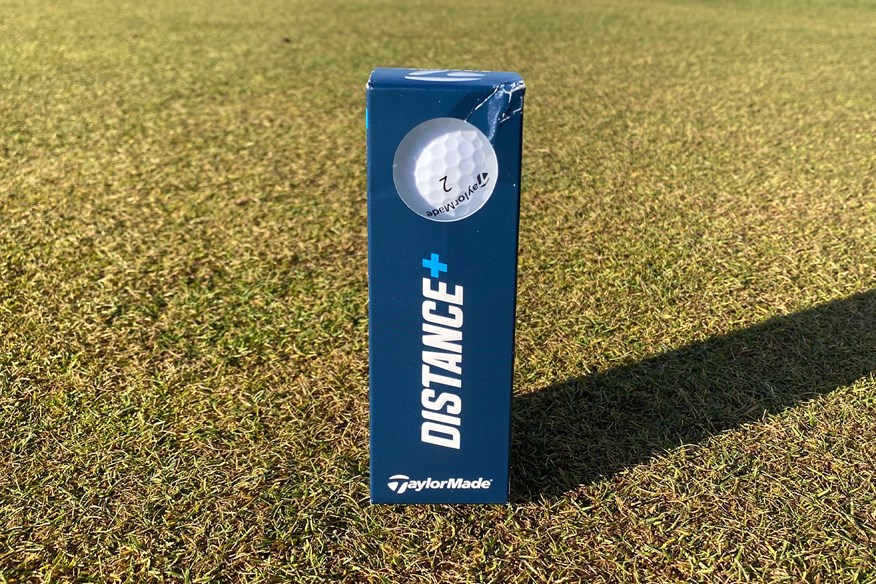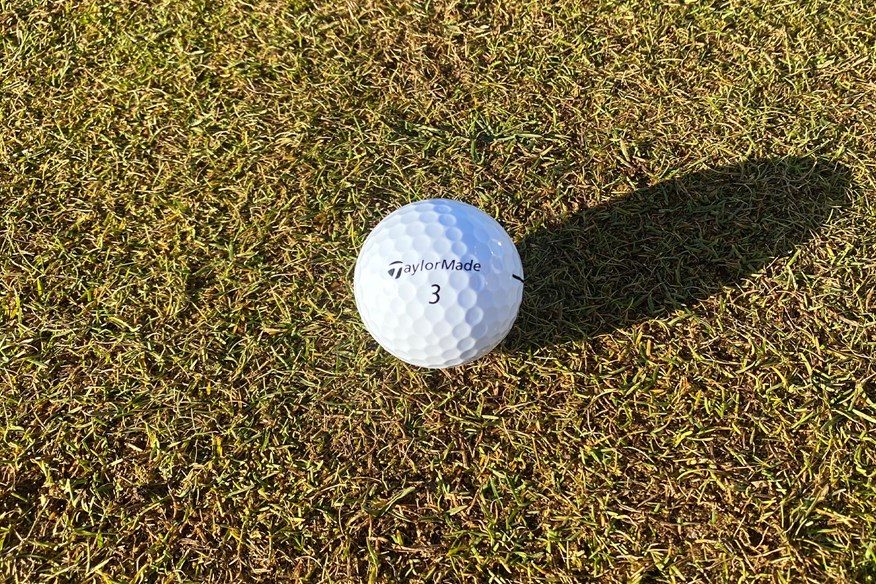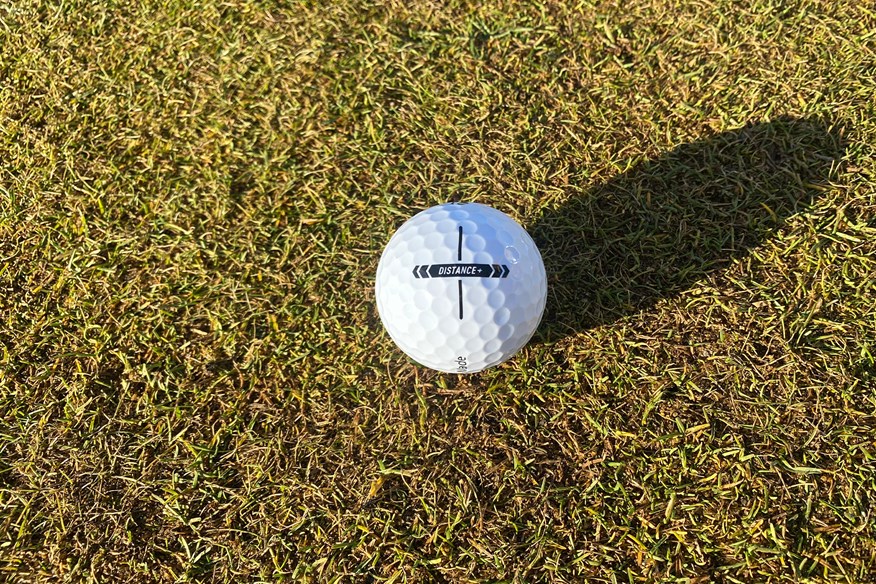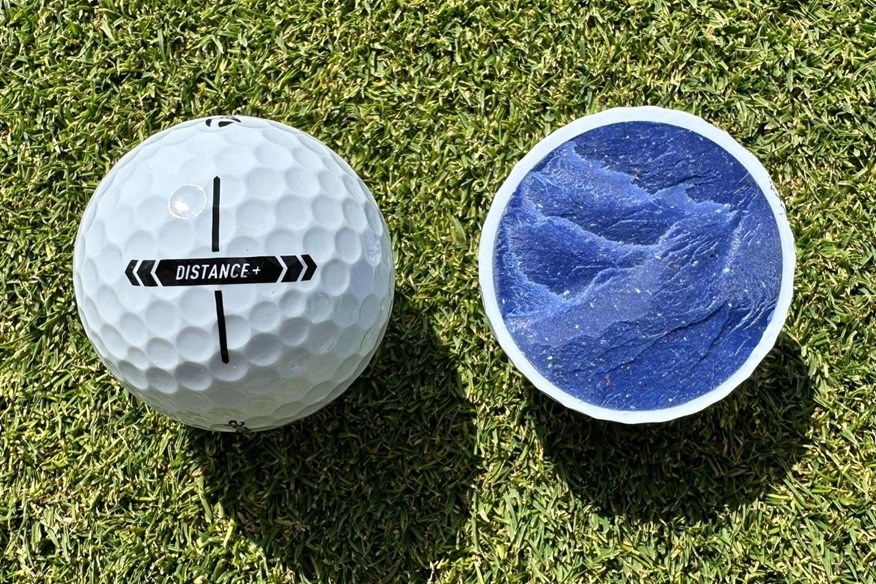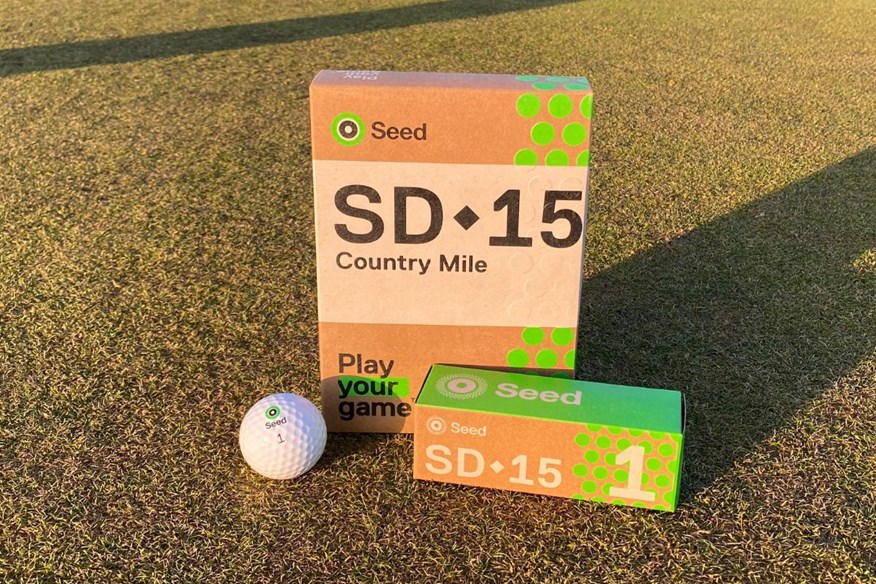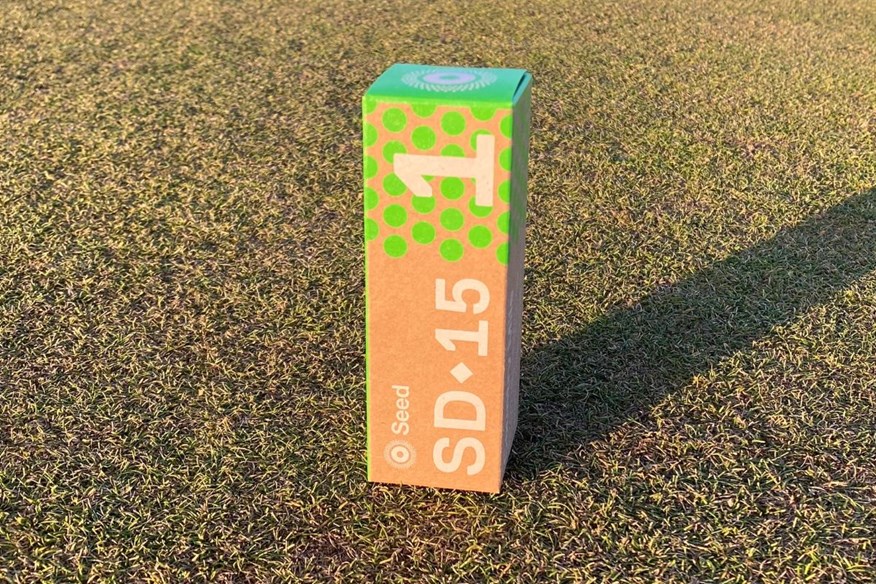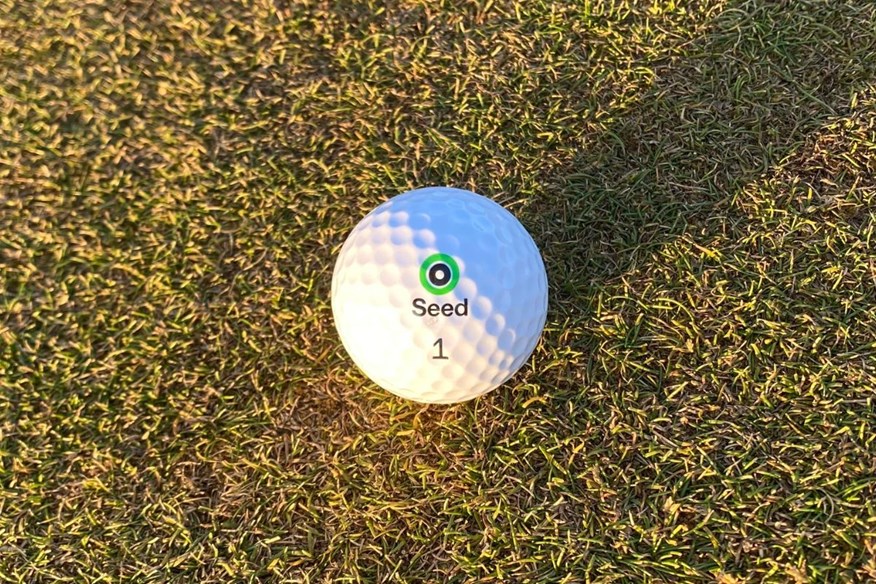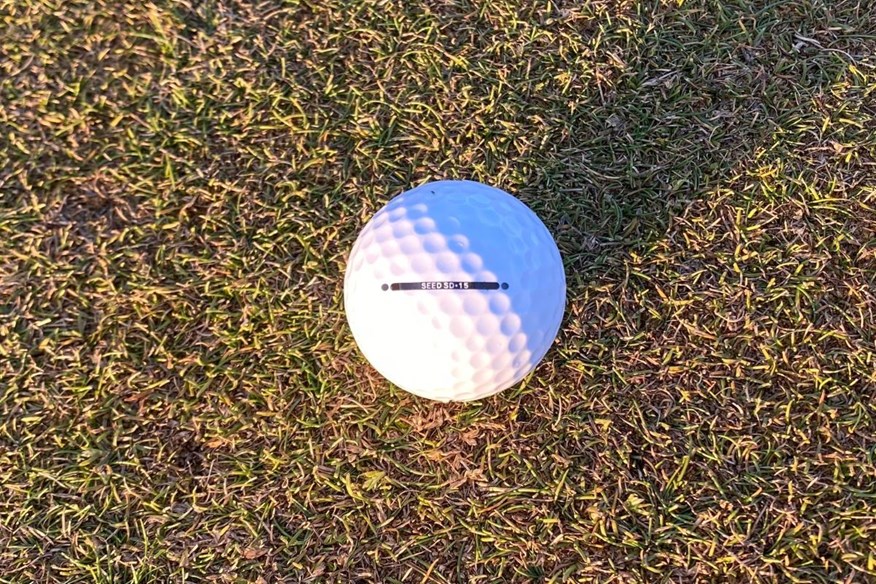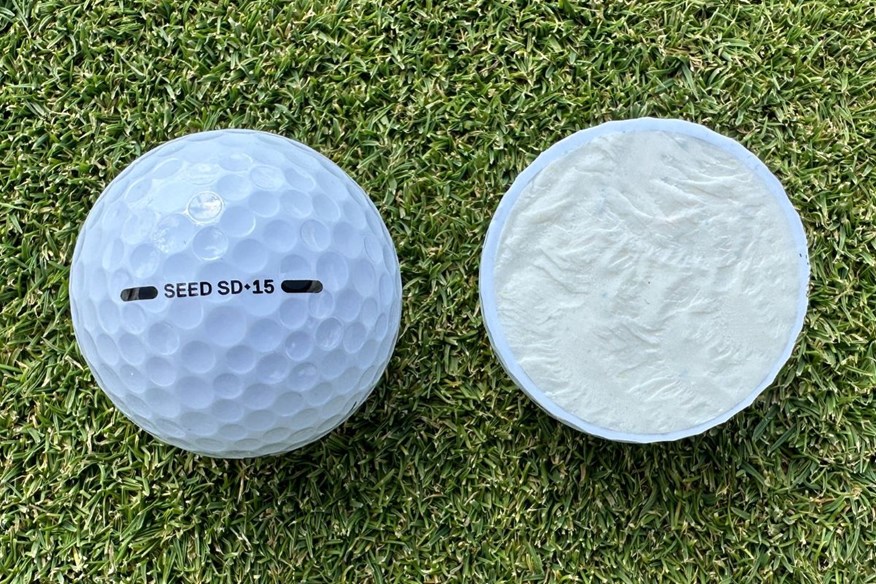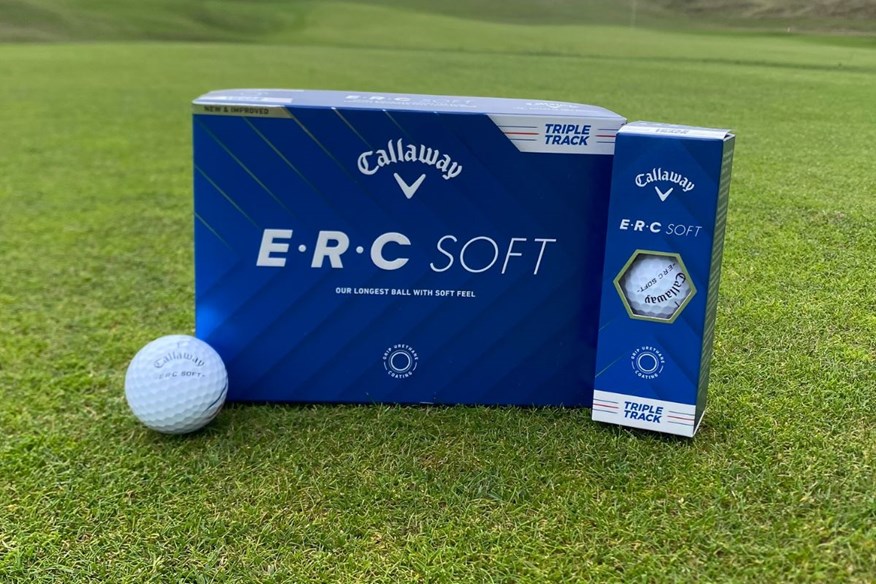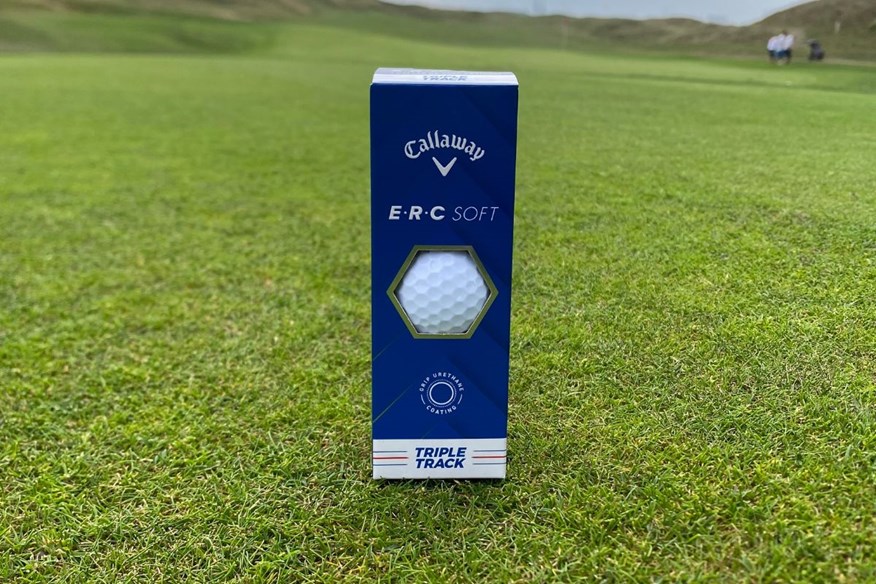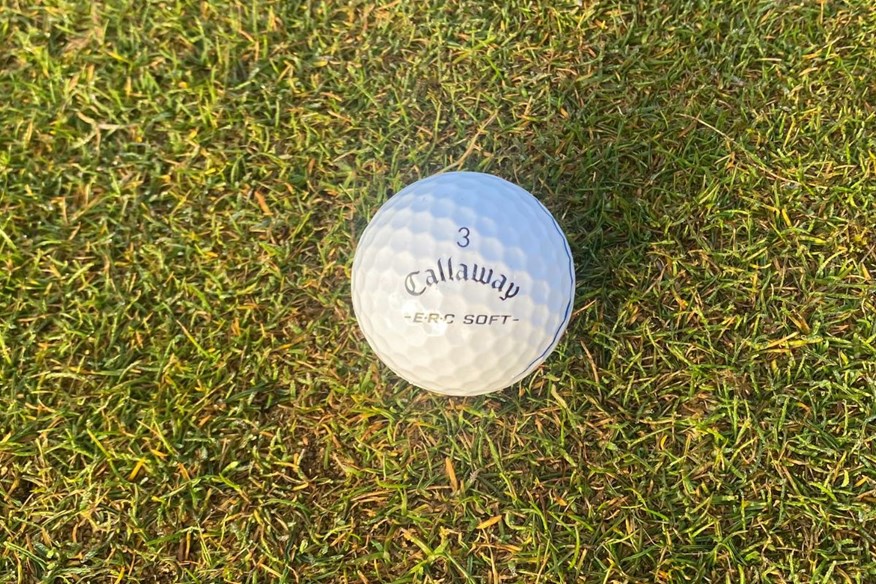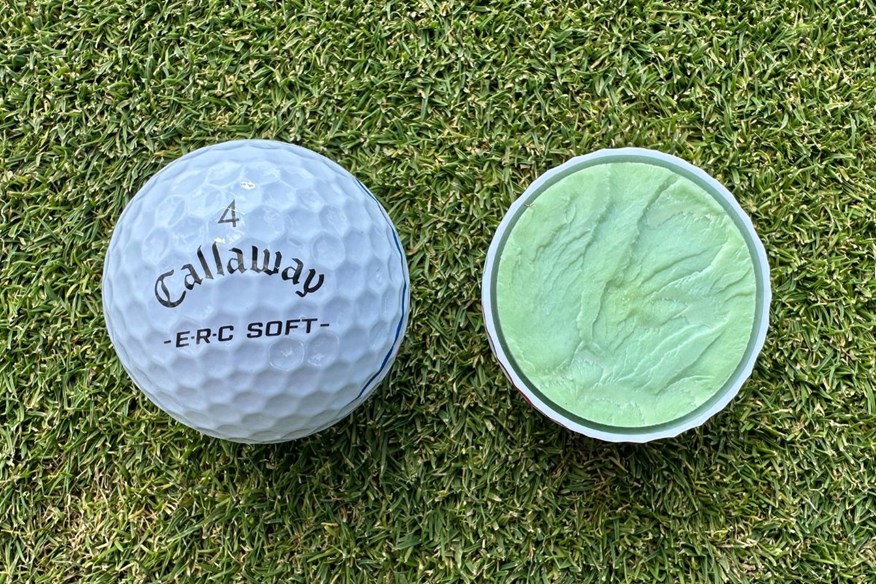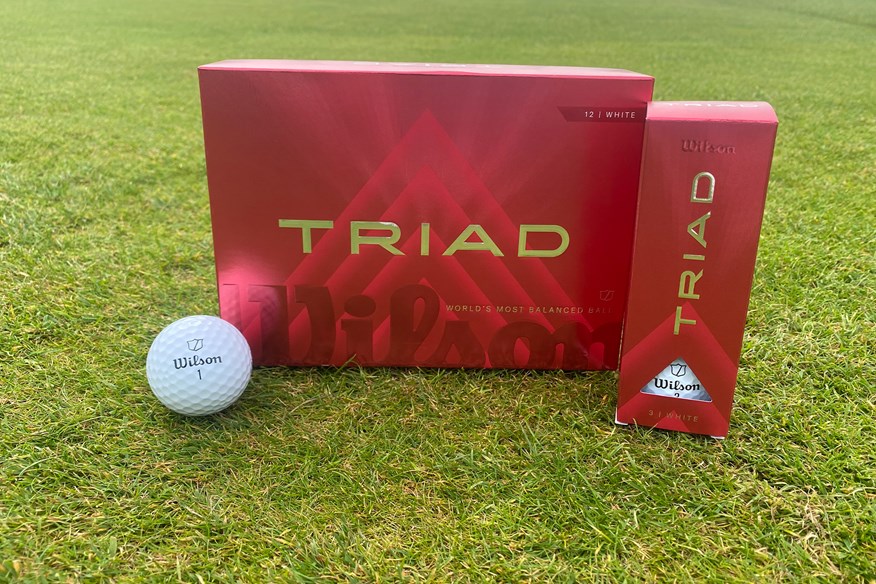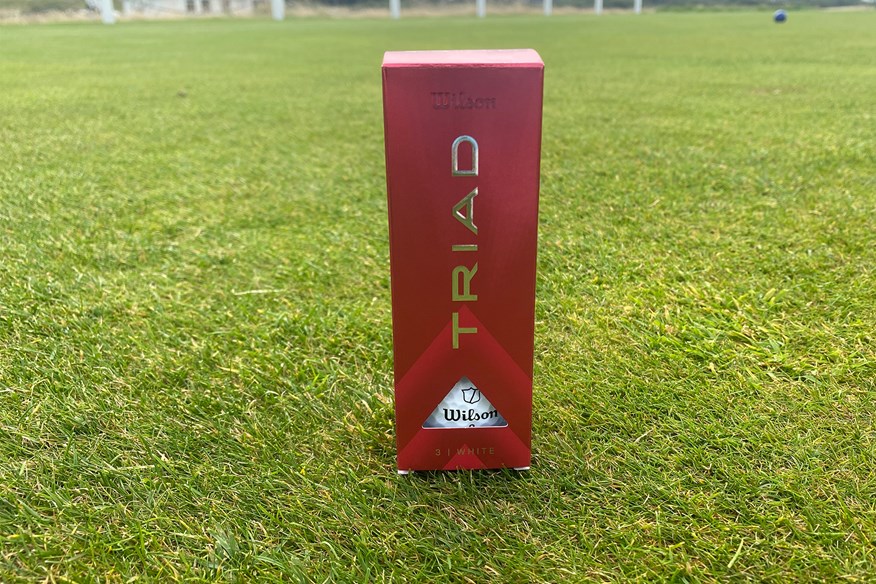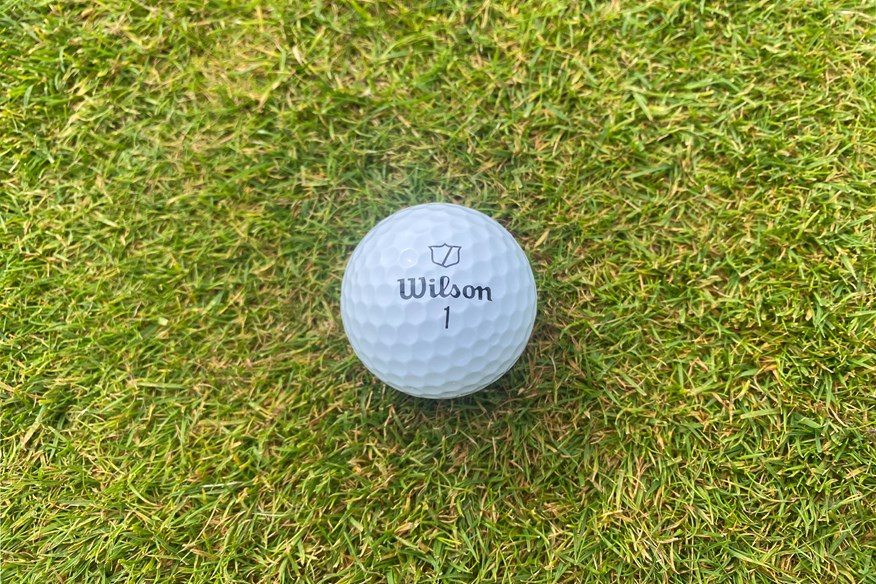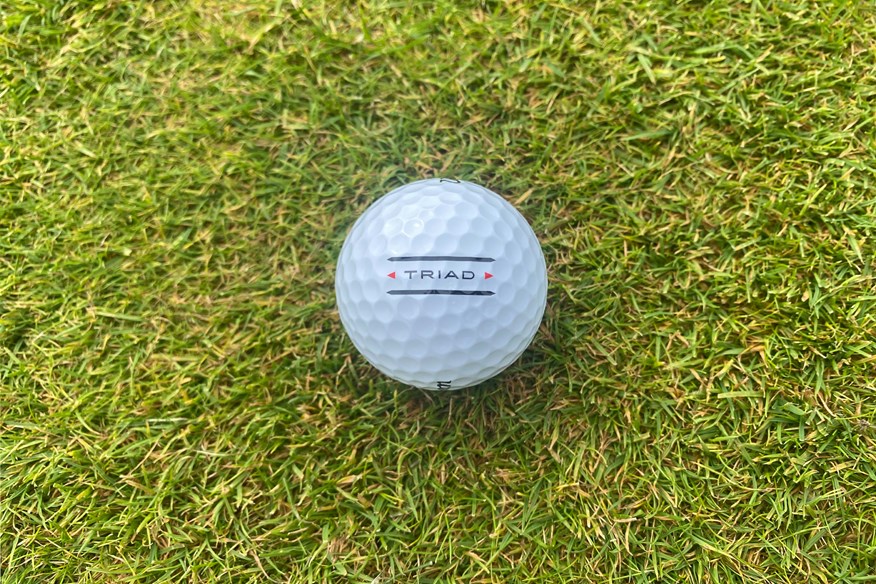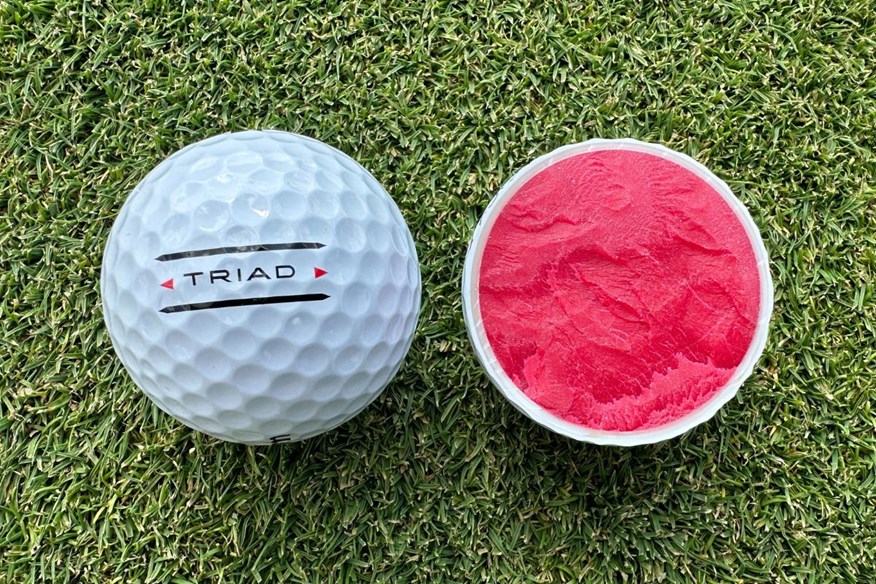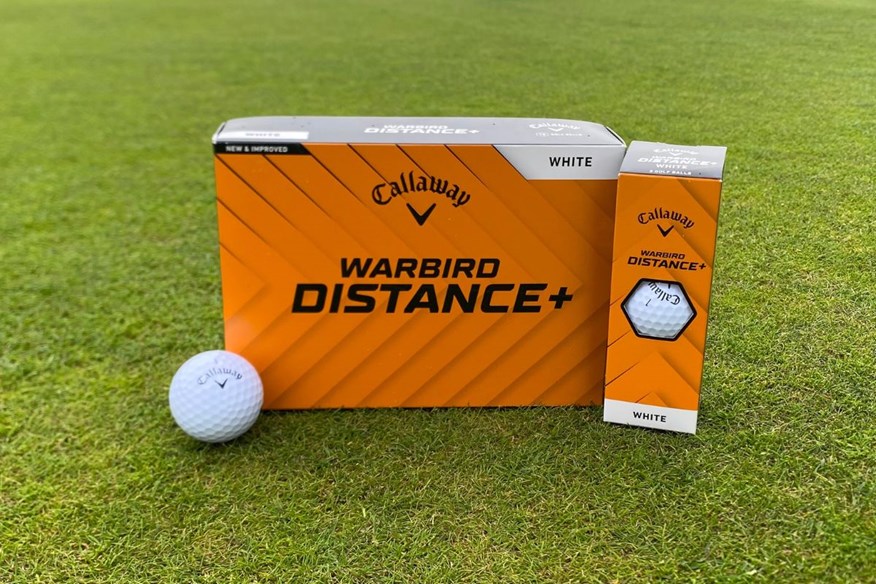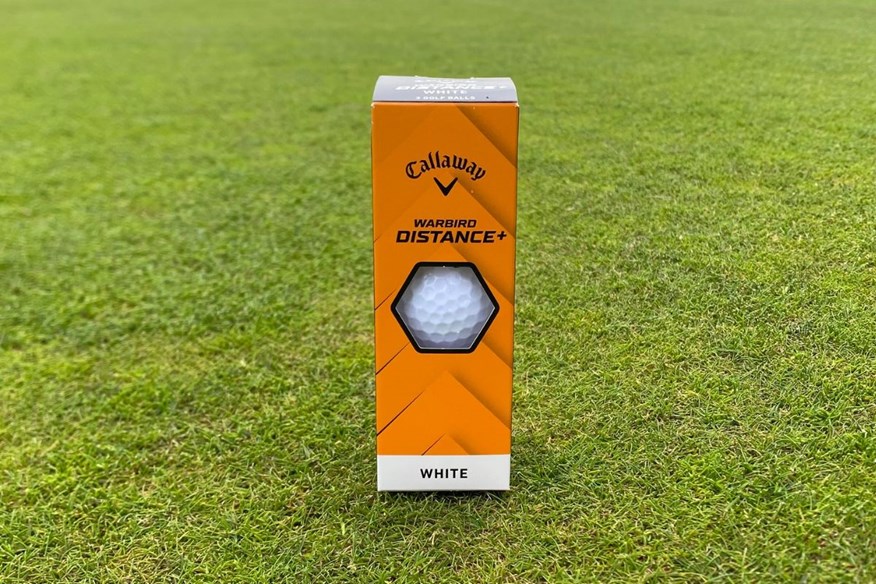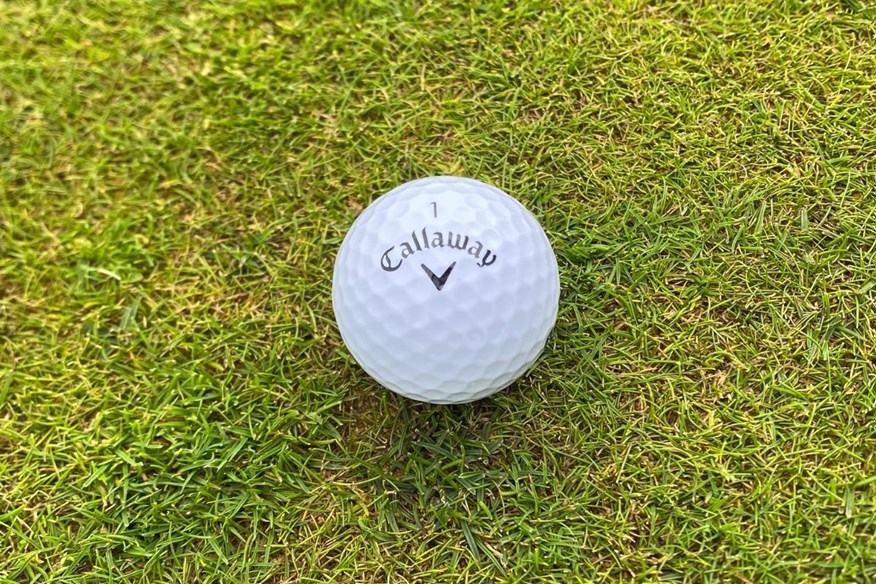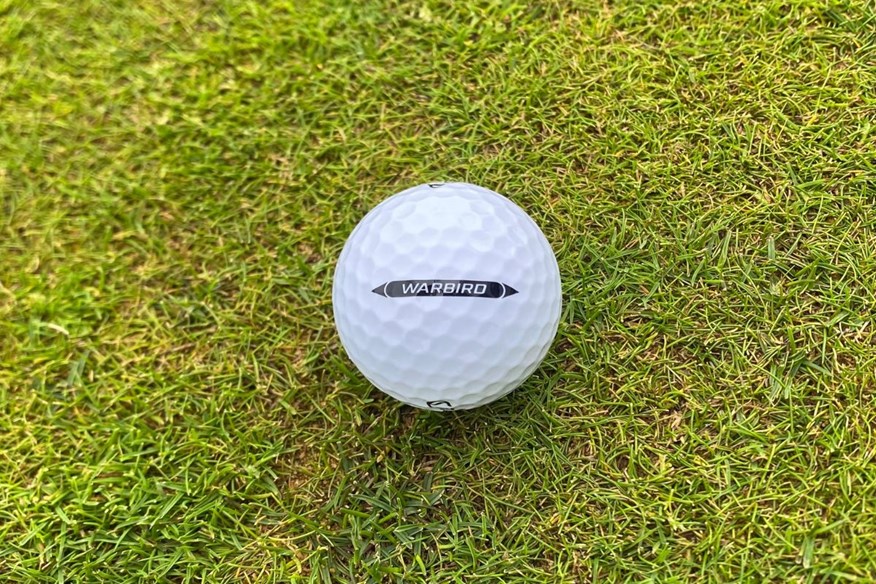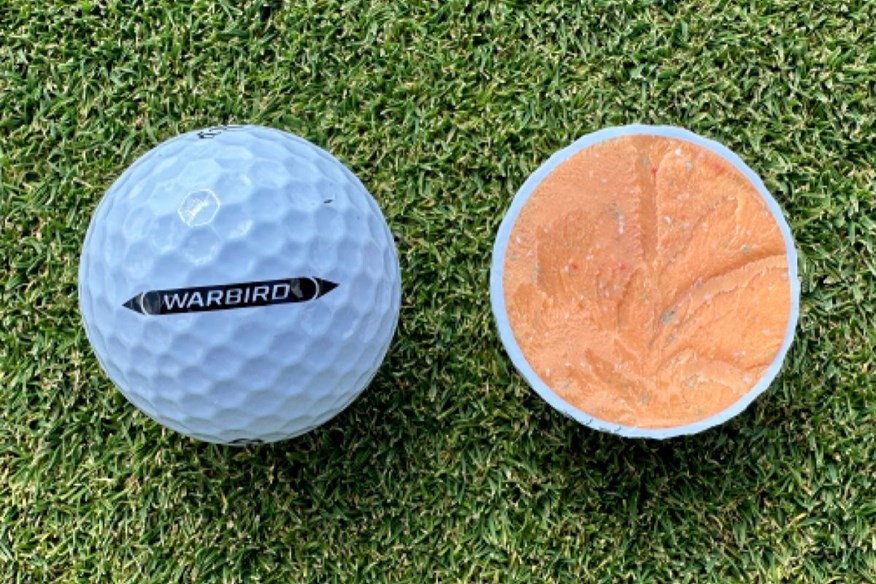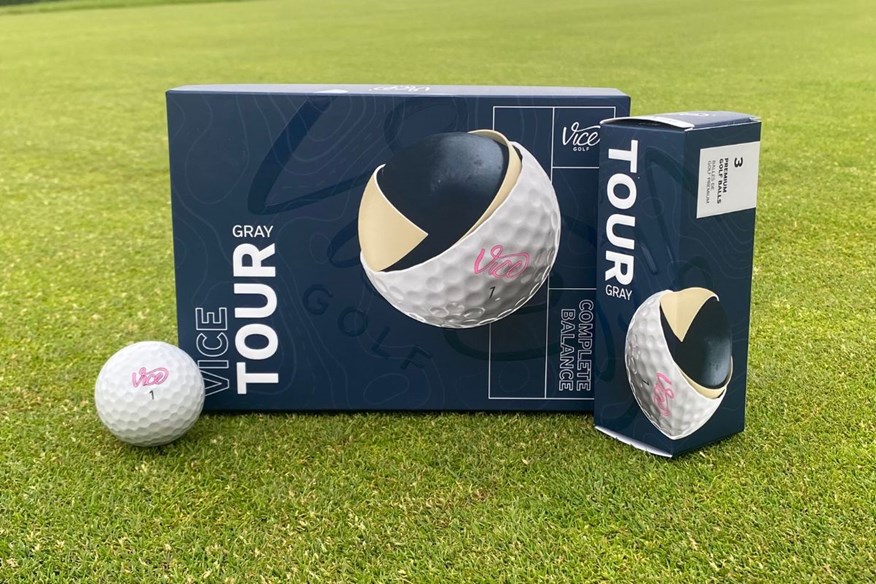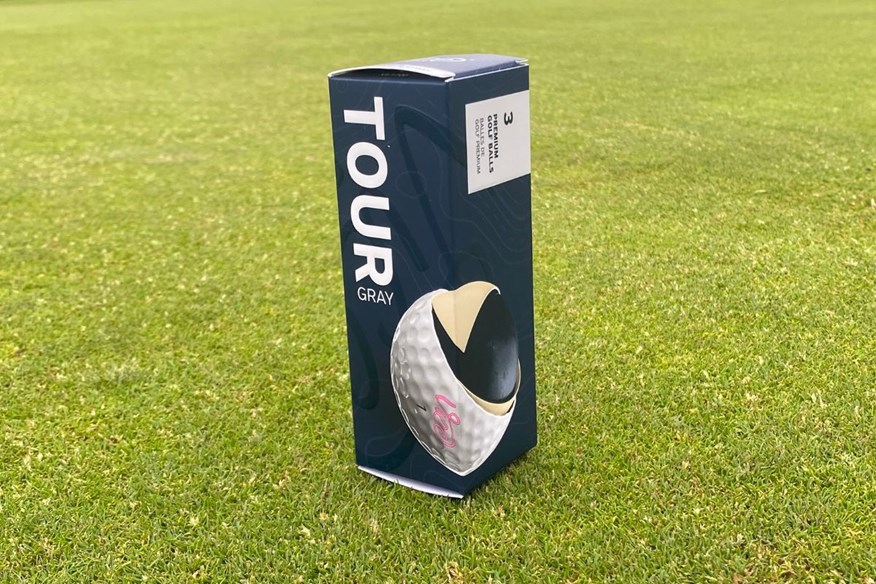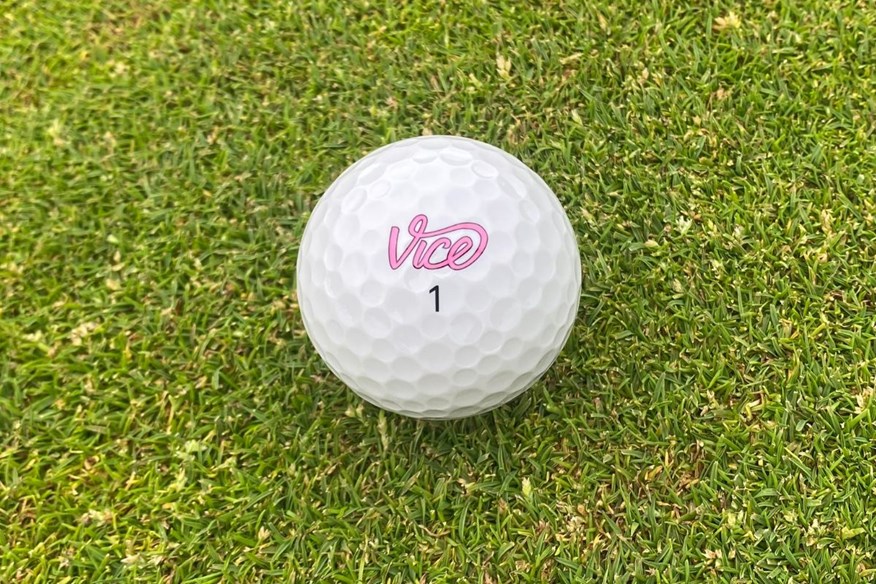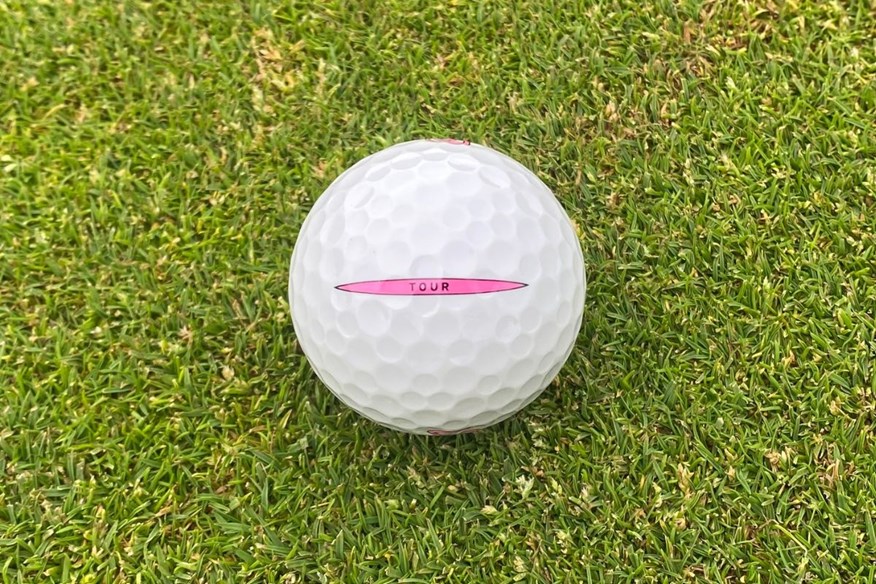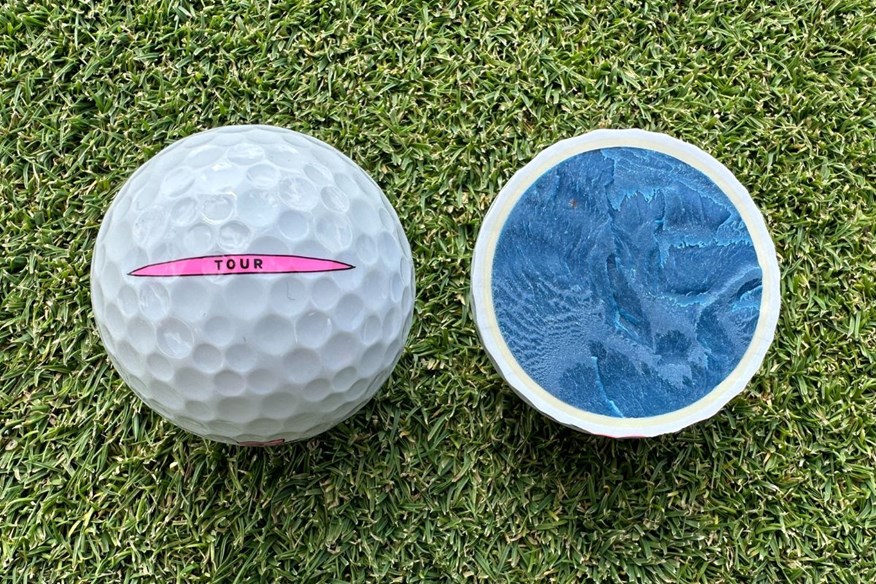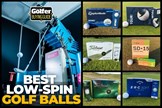Best low-spin golf balls 2025: 62 models robot tested to help you unlock increased distance
Last updated:
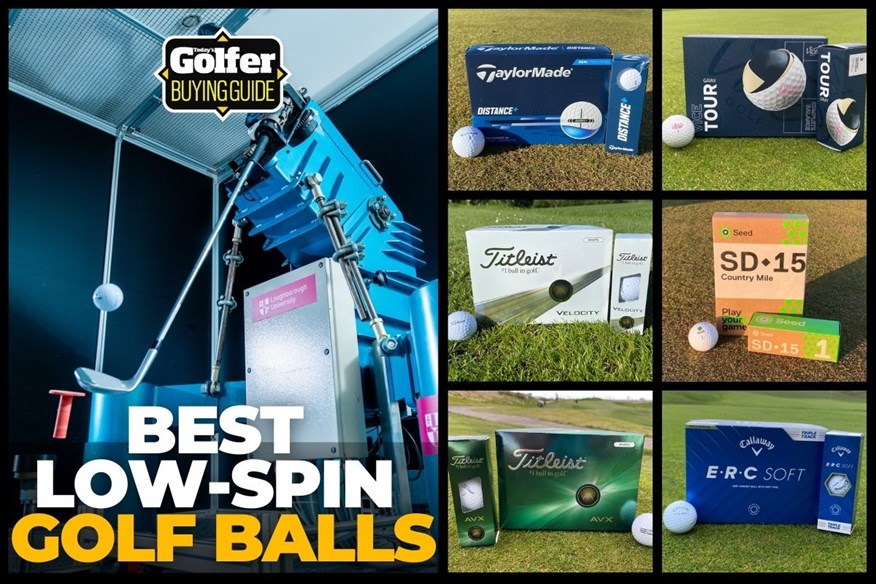
Click here to find out how we conducted our 2025 golf balls test
We’ve tested 62 golf balls from 13 brands on an R&D robot as well as on-course to provide you with a selection of the best high-spin golf balls. So, instead of splashing out on new clubs in an attempt to increase your distance, why not switch to one of the best low-spin golf balls and watch the ball fly past your playing partners?
Jump to:
Playing with one of the best low-spin golf balls could be the answer to all of your problems on the golf course. If you struggle to keep the ball within the Earth’s stratosphere, generate optimum distance off the tee, or if your approach shots balloon into the air and fall out of the sky, it might not be the best golf ball for you. You should consider one of the best low-spin golf balls because it will give you the distance and lower ball flight you need.
To help you in your search for the right golf ball, we carried out our biggest ever golf ball robot test – 62 models from 13 manufacturers. As well as testing on the robot, every golf ball has been tested on-course to provide you with a personal verdict. Click the links below to see how we completed this year’s robot test and to find out exactly how we test golf equipment.
- 2025 golf ball robot test: 62 golf balls, 2,232 shots, 50,000 data points… find out what’s No.1 for you
- How we test golf equipment at Today’s Golfer
Every golfer wants to find a happy balance between having a golf ball that flies far and high off the tee and chases down the fairway while also delivering a towering ball flight when hitting into greens and stopping on a dime – unless you have the ability of a Tour professional, chances are you’ll struggle to find a perfect balance.
If you feel as though you generate too much spin off the tee and when attacking pins, so much so that it hinders the distance you’re able to produce, then playing a low-spin golf ball should help you achieve more optimum levels of spin to allow you to continue finding fairways and hitting and holding greens, but with increased distance and ease.
One of my most used sayings when discussing golf balls is that spin is your friend, because this applies to more golfers. There aren’t many average golfers who will need to play with one of the best low-spin golf balls. The majority of average golfers will probably benefit more from playing with one of the best high-spin golf balls. Whether you need to increase or reduce spin, playing with one of the best golf balls for spin will undoubtedly help in your quest.
Best low-spin golf balls: At a glance
Best overall: TaylorMade Distance+ | View offer
Best DTC: Seed SD-15 | View offer
Best three-piece: Titleist AVX | View offer
Best premium: Titleist Pro V1x Left Dash | View offer
If you’re one of those golfers who are constantly shouting at your ball to “go” or begging it not to fly into orbit, then you should strongly consider one of the best low-spin golf balls. If, after reading through our top picks of 2025, you’re still unsure as to which model will serve you best, read through our extensive buying guide and our answers to the FAQs at the bottom of this page.
Many of the best low-spin golf balls feature among the best distance golf balls and the best golf balls for beginners and high-handicappers because they incorporate fewer layers, which hinders them from generating high levels of spin. If you’re looking to increase spin, then the best premium golf balls are worth considering.
Finding value with low-spin golf balls is much easier than if you need to play with one of the best high-spin golf balls, not only because some of the best cheap golf balls also rank among the best low-spin golf balls, but also because they are quality golf balls at a very fair price. Some golfers do enjoy only playing with premium golf balls, and you still can do so if you need a low-spinning model.
The best low-spin golf balls don’t feature all of the lowest-spinning golf balls of 2025 because some of the lowest-spinning models don’t perform well. Instead, we’ve selected the lowest-spinning balls that still deliver great performance. If you’re interested in playing with the lowest-spinning golf ball, and you’re not interested in any other areas of performance, then you’ll want to play with the Callaway Supersoft.
Best low-spin golf balls 2025
Bronze medal for tee to green performance at 78mph
The TaylorMade Distance+ is towards the top of the leaderboard at all three driver swing speeds, which is exactly where you'd expect it to be. However, we didn't expect it to perform as well in approach play performance as it did.
The Distance+ is the bronze medal winner for tee to green performance at 78mph, and while a factor of that is its off-the-tee performance (161yds carry distance and 113mph ball speed), a greater factor is its approach play performance.
Generating 4,596rpm makes this the third-highest-spinning golf ball, and with a descent angle of 45.1°, it's the third-steepest landing two-piece golf ball. Definitely not what we expected of a distance model.
Sadly, spin does drop around the greens. For short game performance, the Distance+ is the lowest-spinning golf ball of the entire test (3,685rpm).
However, given how strong the Distance+ performs from tee to green, you might not miss many greens. As long as you're able to play with more roll out on the greens, the Distance+ is a great golf ball at an amazing price.
Low-spin is definitely a characteristic of the Distance+. Overall, this is the lowest-spinning golf ball on test, generating 15,775rpm across all three driver swing speeds, the 7-iron shot, and the 40-yard pitch. However, unlike other low-spin golf balls, the Distance+ delivers with its performance, so if you need to lower spin, this is the model to consider.
On-course verdict
I really like the TaylorMade Distance+, I think it's a much better golf ball than many people will imagine.
One area that really impresses me on course is this model's short game performance. I know it didn't perform well in our robot test, but on the golf course, I've never had an issue stopping this golf ball quickly, playing around the greens.
This is a really solid golf ball from tee to green, and one I recommend to anyone looking for a cheaper golf ball that performs everywhere on the golf course.
Pros
- Solid tee-to-green performance
- Strong approach play performance
- Impressive performer on-course
Cons
- Lowest-spinning golf ball around the greens
| Carry distance (yds) | Driver 114mph - 270.9 | Driver 93mph - 208.3 | Driver 78mph - 161 | 7-iron - 155.7 |
| Ball speed (mph) | Driver 114mph - 162.9 | Driver 93mph - 133.4 | Driver 78mph - 113 | 7-iron - 108..5 |
| Backspin (rpm) | Driver 114mph - 2,704 | Driver 93mph - 2,476 | Driver 78mph - 2,314 | 7-iron - 4,596 | Pitch - 3,685 |
| Launch angle (°) | Driver 114mph - 11.1 | Driver 93mph - 13 | Driver 78mph - 14.1 | 7-iron - 21.2 | Pitch - 36.5 |
| Descent angle (°) | Driver 114mph - 37.1 | Driver 93mph - 31.2 | Driver 78mph - 27 | 7-iron - 45.1 | Pitch - 42.7 |
| Peak height (yds) | Driver 114mph - 32 | Driver 93mph - 21.8 | Driver 78mph - 15.4 | 7-iron - 29.6 | Pitch - 78.9 |
| Compression (psi) | 95 |
- React speed core
- Ultra-soft feel
- Aerodynamic dimple pattern
- Plus alignment aid
- 342 dimples
- 2-Piece construction
- Available in white and yellow
Titleist's best 2-piece golf ball for off-the-tee performance
Best Titleist low-spin golf ball
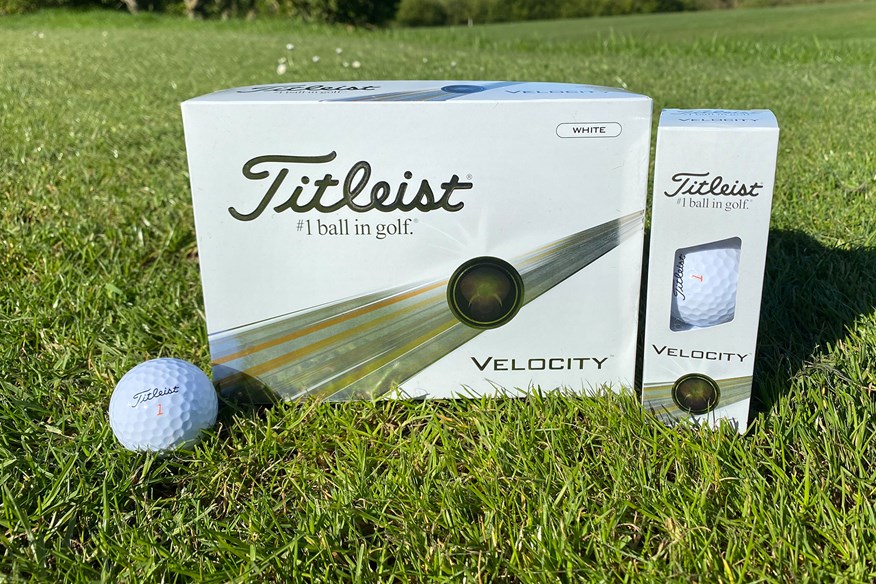


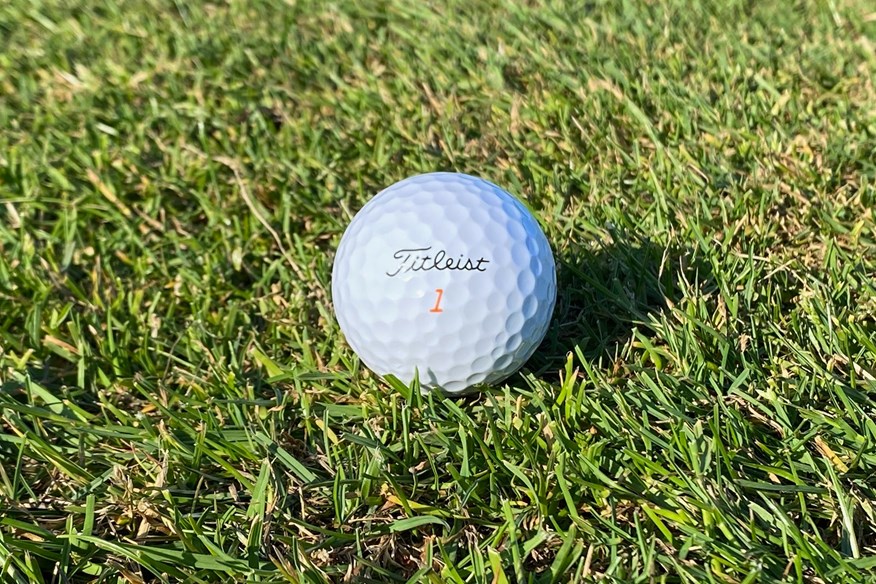
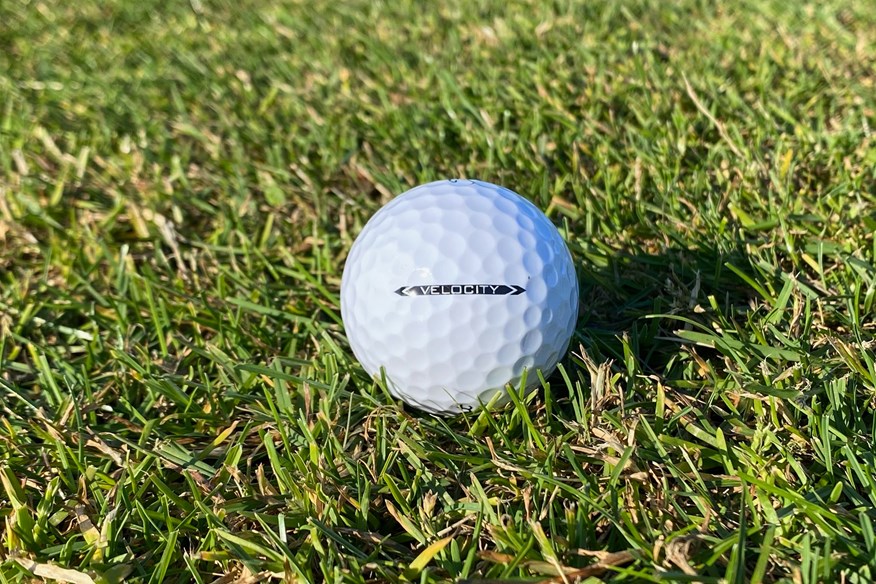
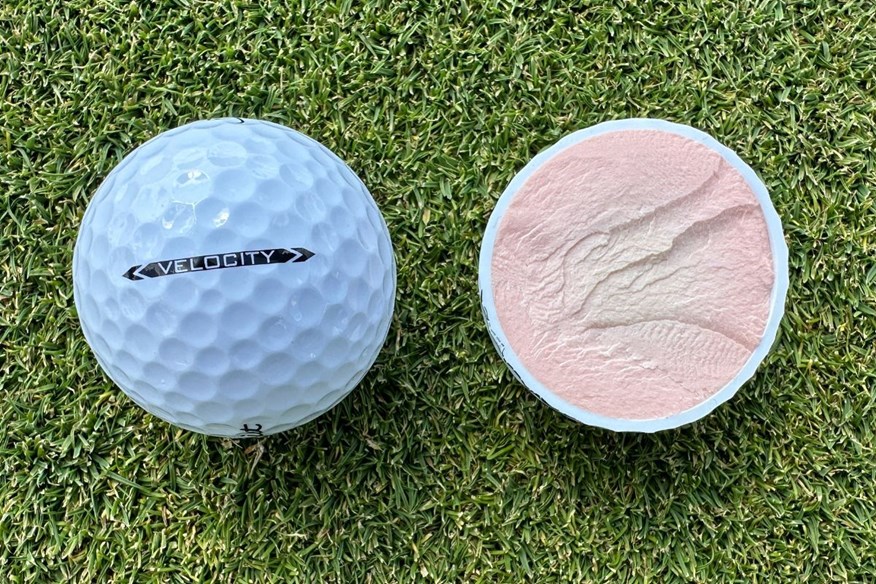
Across all three swing speeds, the Velocity is the fourth-best two-piece golf ball for overall performance off the tee. We fully expected the Velocity to perform well off the tee because it's a distance golf ball, but if we're being honest, we didn't expect it to outperform the four-piece Pro V1x.
The velocity delivered its best performance at 114mph. At the quickest swing speed we tested, the Velocity produced 271.5 carry yards and 163.2mph ball speed.
In approach play, the Velocity is the lowest-spinning golf ball (3,081rpm) and longest (160.6yds) out of all 62 models we tested. That's potentially expected given it's a distance golf ball.
However, the Velocity's short game performance is much better than we expected. This golf ball is the fifth-highest-spinning two-piece model, with 5,789rpm.
Despite the high greenside spin of the Velocity, this still emerges from the test as one of the best-low-spin golf balls, generating 16,995rpm across all three driver swing speeds, the 7-iron shot, and the 40-yard pitch.
It is a noticable jump (over 1,000rpm) from the Maxfli StraightFli, but that's because the balls in between the StraightFli and Velocity might be lower-spinning than this model, but they aren't as strong in their overall performance.
The Titleist Velocity delivers competitive distance and overall performance for all golfers. You're guaranteed distance, but you're also getting a golf ball that can perform around the greens.
On-course verdict
I'm quite the fan of Velocity. In the right hands, this can be a very strong performing golf ball. However, in the wrong hands, it can majorly hinder your game.
For my game, off the tee, Velocity performs very closely to the Pro V1x, but as I approach the green, distance begins to outweigh spin, which isn't something I require.
If you're a golfer who's looking to reduce spin and gain distance, Velocity has to be on your radar, especially at its price.
This is a two-piece golf ball, but I honestly think it's hard to tell. If I weren't able to distinguish this golf ball in Titleist's line-up by its orange numbers, I think you could trick me into thinking it's the Pro V1x based on its long game performance. Take it to the short-game area, and it's very easy to see this is a distance golf ball.
Pros
- Very competitive distance
- Great value
- Good feel and feedback
Cons
- Difficult to control around the greens
| Carry distance (yds) | Driver 114mph - 271.5 | Driver 93mph - 208.9 | Driver 78mph - 160.6 | 7-iron - 160.6 |
| Ball speed (mph) | Driver 114mph - 163.2 | Driver 93mph - 133.5 | Driver 78mph - 112.9 | 7-iron - 108.7 |
| Backspin (rpm) | Driver 114mph - 2,677 | Driver 93mph - 2,467 | Driver 78mph - 2,261 | 7-iron - 3,801 | Pitch - 5,789 |
| Launch angle (°) | Driver 114mph - 11.1 | Driver 93mph - 13.2 | Driver 78mph - 14.2 | 7-iron - 21.9 | Pitch - 31.2 |
| Descent angle (°) | Driver 114mph - 36.9 | Driver 93mph - 31.5 | Driver 78mph - 26.8 | 7-iron - 44 | Pitch - 36.7 |
| Peak height (yds) | Driver 114mph - 31.8 | Driver 93mph - 22.2 | Driver 78mph - 15.3 | 7-iron - 29.6 | Pitch - 7.1 |
| Compression (psi) | 101 |
- High-speed LSX core
- Fast NAZ+ cover
- Spherically-tiled octahedral dimple pattern
- 350 dimples
- 2-Piece construction
- Available in white, green, and orange
Seed's cheapest golf ball
The Seed SD-15's biggest positive is definitely its price. This is a very average golf ball up against the other 61 in the test, but in the two-piece category, it fares well.
This golf ball isn't taking home any awards, but it does perform admirably in approach play and short game performance. Approach play performance is where the SD-15 achieved its highest ranking of fifth in this category. Short game performance is also strong, up against two-piece models, with the SD-15 finishing sixth overall.
Off the tee, it's sadly a different story. The SD-15 is towards the bottom of the rankings. However, it is better off the tee than the three-piece SD-05.
Despite being the cheapest Seed golf ball, the SD-15 definitely isn't the worst - that goes to the SD-05. For the price, the SD-15 is well worth your consideration, especially if performance off the tee isn't what your golf game is lacking.
Interestingly, the SD-15 is one of the best low-spin golf balls, but it doesn't deliver strong distance. The SD-15 is the model to consider in this category if you want to drop spin across the board, and you're not bothered about adding distance. Overall, the SD-15 generates 17,164rpm across all three driver swing speeds, the 7-iron shot, and the 40-yard pitch.
On-course verdict
My favorite aspect of the Seed SD-15 is its feel. This isn't a soft golf ball, and that might not appeal to everyone, but it definitely does to me. The slightly firmer-than-soft feel means the SD-15 provides strong feedback.
From tee to green, the SD-15 doesn't blow me away with its performance, but it's respectable enough not to make me completely dismiss it.
I'm not interested in distance, which I think makes the SD-15 more appealing to me because its strongest area on the course is around the green.
Pros
- Strong feedback due to firmer feel
- Good greenside spin and control
- Admirable approach play performance
Cons
- Not the longest golf ball
| Carry distance (yds) | Driver 114mph - 263.5 | Driver 93mph - 204 | Driver 78mph - 158.9 | 7-iron - 157.6 |
| Ball speed (mph) | Driver 114mph - 159.6 | Driver 93mph - 131.7 | Driver 78mph - 112 | 7-iron - 108.3 |
| Backspin (rpm) | Driver 114mph - 2,612 | Driver 93mph - 2,482 | Driver 78mph - 2,233 | 7-iron - 4,170 | Pitch - 5,667 |
| Launch angle (°) | Driver 114mph - 11 | Driver 93mph - 13 | Driver 78mph - 14.4 | 7-iron - 21.7 | Pitch - 31.4 |
| Descent angle (°) | Driver 114mph - 35.4 | Driver 93mph - 30.8 | Driver 78mph - 26.8 | 7-iron - 44.6 | Pitch - 37.1 |
| Peak height (yds) | Driver 114mph - 29.5 | Driver 93mph - 21.1 | Driver 78mph - 15.2 | 7-iron - 29.6 | Pitch - 7.3 |
| Compression (psi) | 64 |
- Thinner Surlyn cover
- Low compression core
- 332 dimples
- 2-Piece construction
- Available in white, yellow, green, and red
- Alternative models include The Jack and SYNCR
Bronze medal for tee to green performance at 114mph
Best three-piece low-spin golf ball



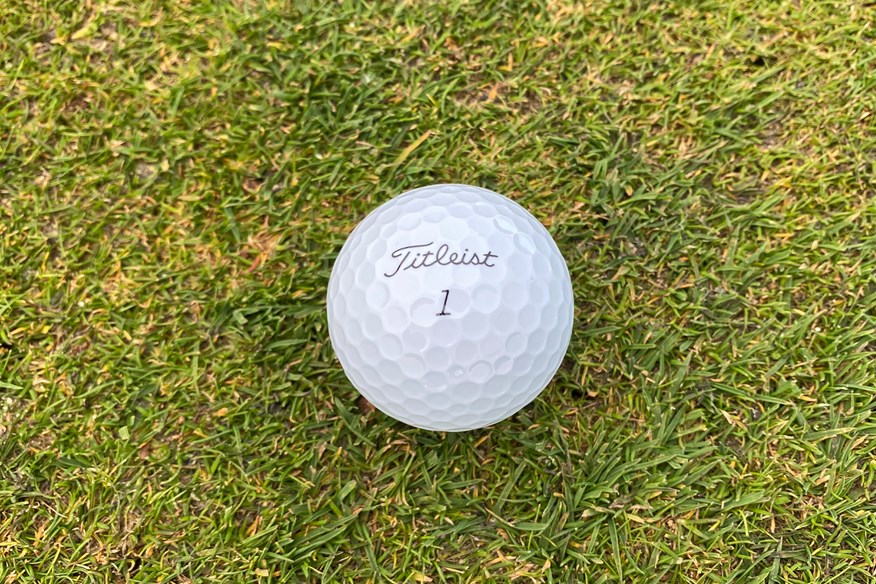
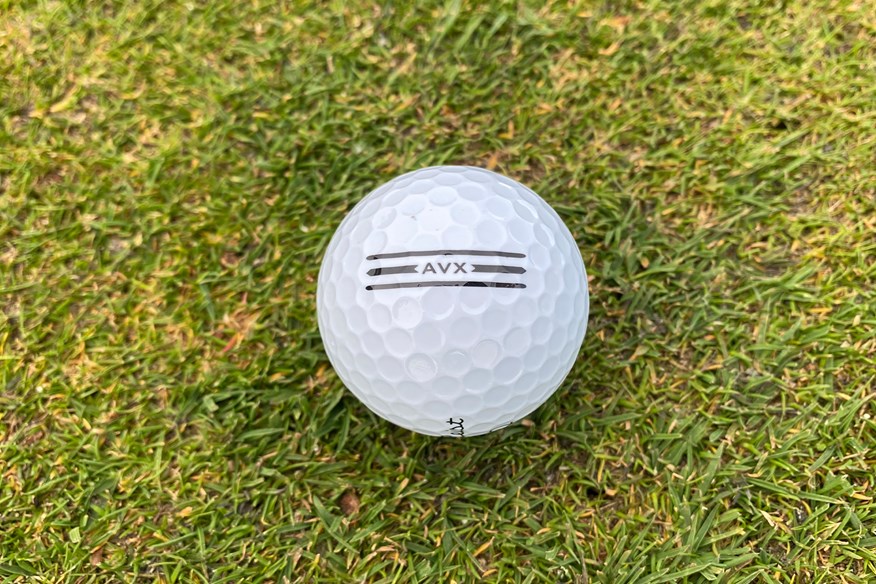

The AVX is an outstanding golf ball that some people might consider to be a Tour-level golf ball, but our opinion is, compared to the Pro V1, this golf ball sits more in line with 3-piece club golfer models.
It's hardly surprising the AVX is a medal winner for tee to green performance at 114mph, given this golf ball's characteristics. The bronze medal might not be as high as expected, but it had good opposition ahead. Titleist sells the AVX as a long, low-spin, low-flying golf ball offering amazing feel and greenside control.
Approaching and playing around the greens, AVX is a low-spinning golf ball, but that's as expected. It's difficult to comment on control from the robot test data, but given the descent angles both with the 7-iron and pitch shots, you should expect good control even if spin isn't the highest.
Moving to the tee box, moderate and quick swing speeds is where the AVX performs highest. At 114mph, it's one of only three golf balls in its category to travel farther than 271 yards, it's the third fastest golf ball, and the lowest-spinning. AVX is the second-longest golf ball at 93mph (same ranking as 114mph), fourth fastest, and fourth lowest-spinning.
Dropping down to 78mph, the AVX didn't rank within the top three for carry, speed, or spin.
Titleist's AVX is a solid 3-piece club golfer golf ball because of how versatile it is. No matter how fast you swing a golf club, the AVX will serve you well.
This is the best three-piece low-spin model on test. A couple of three-piece golf balls did produce less spin than the AVX across all three driver swing speeds, the 7-iron shot, and the 40-yard pitch. But with 17,375rpm and factoring in overall performance, the AVX takes the award.
On-course verdict
The Titleist AVX doesn't present itself to me as a golf ball I would want to play often. However, in the right - or should I say wrong - conditions, I do enjoy playing with AVX.
From the AVX, you're guaranteed a golf ball that's going to fly low and generate low-spin. For that very reason, I enjoy playing with AVX in windy conditions on the links.
The short game performance has noticeably improved from the previous generation, and so has the feel and response.
The AVX is a very pleasurable golf ball, especially if you're looking to fly a ball lower and generate less spin.
Read our full Titleist AVX golf ball review.
Pros
- Brilliant long game performance
- Short game performance has been improved over the previous model
- Low and piercing ball flight is amazing in windy conditions
Cons
- Lower ball flight won't be the preference of every golfer
| Carry distance (yds) | Driver 114mph - 271.1 | Driver 93mph - 208.1 | Driver 78mph - 160.4 | 7-iron - 156 |
| Ball speed (mph) | Driver 114mph - 162.8 | Driver 93mph - 133.3 | Driver 78mph - 112.9 | 7-iron - 108.2 |
| Backspin (rpm) | Driver 114mph - 2,613 | Driver 93mph - 2,606 | Driver 78mph - 2,408 | 7-iron - 4,429 | Pitch - 5,318 |
| Launch angle (°) | Driver 114mph - 11.1 | Driver 93mph - 13 | Driver 78mph - 14 | 7-iron - 21.2 | Pitch - 32 |
| Descent angle (°) | Driver 114mph - 36.4 | Driver 93mph - 32 | Driver 78mph - 27.1 | 7-iron - 44.7 | Pitch - 37.9 |
| Peak height (yds) | Driver 114mph - 31.4 | Driver 93mph - 22.3 | Driver 78mph - 15.3 | 7-iron - 29.2 | Pitch - 7.4 |
| Compression (psi) | 84 |
- Large high-speed, high-gradient core
- Proprietary urethane cover
- Upgraded thin high-flex casing layer
- Aerodynamic dimple pattern
- 346 dimples
- 3-Piece construction
- Available in white and yellow
- An alternative model is the AIM 360
Gold medal for tee to green performance at 78mph and off-the-tee performance
The Callaway ERC Soft outshines the Chrome Soft in the three-piece club golfer category, mainly due to its tee to green performance. The ERC Soft is the best golf ball in this category for tee to green performance at 78mph and the third-best at 93mph. Another award for this golf ball is the gold medal for off-the-tee performance.
This is a super strong golf ball off the tee - it's by far the best at 78mph with 161.4 carry yards and 113.2mph ball speed. At 93mph, it's right up there again, ranking first for carry distance (208.3yds) and second for ball speed (133.5mph). At 114mph, three golf balls blow the others away in this category, but the ERC Soft is best-of-the-rest (269.9yds and 162.5mph).
The biggest dip in performance for the ERC Soft is in approach play. This is the second-lowest spinning golf ball (4,154rpm) and has a 44.6° descent angle. That materialises into good distance (158.4yds), but that's not the focal point when playing into greens.
With short game performance, you can expect a golf ball that will grab and spin. The ERC Soft delivers strong spin numbers here with 5,592rpm - higher than the Chrome Soft.
Across all three driver swing speeds, the 7-iron shot, and the 40-yard pitch, the ERC Soft generates 17,420 rpm, making it one of the best low-spin golf balls and Callaway's best low-spin model. Considering this is a high-spinning golf ball around the green, the fact it ends up among the best low-spin golf balls shows how strong its performance is off the tee and how distance-oriented it is in approach play.
The ERC Soft is one of the best three-piece club golfer models, and the fact it outshines the Chrome Soft draws serious, warranted attention.
On-course verdict
The Callaway ERC Soft is a golf ball I really enjoy playing with because it feels like a golf ball you can absolutely hammer, and it will behave. This golf ball's performance from tee to green is nothing to be snubbed at.
Off the tee, the ERC Soft travels well, with minimal long-game spin. For my game, this isn't optimal, but I imagine most golfers will appreciate this. Around the greens, it's a different story. The ERC Soft is easy to control and spin. However, I don't think it's as impressive as the previous generation.
This is a soft-feeling golf ball - as the name suggests - and I find it to be lacking in feedback and response because of how soft it is. You might think otherwise, but personally, I want a golf ball with a touch more feedback.
The ERC Soft is a fantastic golf ball from tee to green at a great price. I prefer this model over the Chrome Soft, although they are both fun golf balls.
Pros
- Very soft feel
- Good tee to green performance
- Impressive distance
Cons
- Lacks feedback and response
| Carry distance (yds) | Driver 114mph - 269.9 | Driver 93mph - 208.3 | Driver 78mph - 161.4 | 7-iron - 158.4 |
| Ball speed (mph) | Driver 114mph - 162.5 | Driver 93mph - 133.4 | Driver 78mph - 113.2 | 7-iron - 108.6 |
| Backspin (rpm) | Driver 114mph - 2,690 | Driver 93mph - 2,635 | Driver 78mph - 2,388 | 7-iron - 4,154 | Pitch - 5,592 |
| Launch angle (°) | Driver 114mph - 11.1 | Driver 93mph - 13 | Driver 78mph - 14 | 7-iron - 21.6 | Pitch - 31.4 |
| Descent angle (°) | Driver 114mph - 36.8 | Driver 93mph - 32.2 | Driver 78mph - 27.3 | 7-iron - 44.6 | Pitch - 37.1 |
| Peak height (yds) | Driver 114mph - 31.5 | Driver 93mph - 22.4 | Driver 78mph - 15.5 | 7-iron - 29.7 | Pitch - 7.3 |
| Compression (psi) | 87 |
- Hyper elastic SoftFast core
- Hybrid cover
- GRIP urethane coating
- High-speed mantle
- Advanced alignment from Triple Track technology
- 332 dimples
- 3-Piece construction
- Available in white and yellow
- Alternative models include Truvis and 360° Fade
Silver medal for approach play performance
We're huge fans of the Wilson Triad at Today's Golfer because it's such a consistent golf ball that you can trust.
The one area where you can really depend on the Triad to perform is when you're approaching greens. This golf ball is the second-best golf ball for approach play performance among the 3-piece club golfer models.
The Triad isn't particularly long (156.4yds) or high-spinning (4,474rpm), but its carry distance consistency is right up there with the best in the entire test, ranking seventh overall.
You're not getting a high-spin golf ball for around the greens with the Triad. This golf ball is below the test average with 5,554rpm.
Off the tee, the Triad is a very average performer at all three swing speeds. Spin does creep up across the board, and that does hurt the Triad for distance.
Overall, the Triad is a low-spinning golf ball. It's not as low-spinning as the Duo Soft, but based on its overall performance, it cements itself as one of the best low-spin golf balls, generating 17,545rpm across all three driver swing speeds, the 7-iron shot, and the 40-yard pitch.
The Triad is also considered to be a low-spin golf ball compared to the high-spinning Staff Model and Staff Model X. If you want to play with a Wilson golf ball that's going to deliver great performance and low spin, look no further than this model.
That being said, the Triad is designed to help golfers break 80, and if you're looking to achieve that, this golf ball is a great companion.
On-course verdict
The Triad isn’t the sexiest of golf balls – no one is turning their head when you announce you’re playing one – but I quite like that. It’s a very practical golf ball, built to help you shoot lower scores.
I don’t think golf balls get more versatile than the Wilson Triad – it epitomizes versatility. I honestly think a scratch golfer or complete newbie could switch to this golf ball and find enjoyment. Triad works for anyone and everyone.
The soft feel doesn’t reduce the responsiveness of the Triad. I find this golf ball to be highly responsive. I think with it having a thin cover, you can really feel the golf ball making contact with the face. I find the feedback gets stronger as you move down your bag. So, the response with a wedge is stronger than the response when you hit driver.
Read our full Wilson Triad golf ball review.
Pros
- Extremely consistent golf ball
- Amazing approach play performance
- Very easy to trust
Cons
- Doesn't blow you away in any area
| Carry distance (yds) | Driver 114mph - 268.2 | Driver 93mph - 205.6 | Driver 78mph - 159.7 | 7-iron - 156.4 |
| Ball speed (mph) | Driver 114mph - 161.7 | Driver 93mph - 132.6 | Driver 78mph - 112.8 | 7-iron - 108.5 |
| Backspin (rpm) | Driver 114mph - 2,734 | Driver 93mph - 2,707 | Driver 78mph - 2,456 | 7-iron - 4,474 | Pitch - 5,554 |
| Launch angle (°) | Driver 114mph - 11.2 | Driver 93mph - 12.7 | Driver 78mph - 13.9 | 7-iron - 21.1 | Pitch - 31.2 |
| Descent angle (°) | Driver 114mph - 37.1 | Driver 93mph - 31.9 | Driver 78mph - 27.6 | 7-iron - 44.7 | Pitch - 36.9 |
| Peak height (yds) | Driver 114mph - 31.7 | Driver 93mph - 21.8 | Driver 78mph - 15.5 | 7-iron - 29.3 | Pitch - 7.2 |
| Compression (psi) | 89 |
- Tri-balanced construction
- High MOI
- Thin, high-friction urethane cover
- 362 dimples
- 3-Piece construction
- Available in white and yellow
Titleist's fastest golf ball
Best premium low-spin golf ball
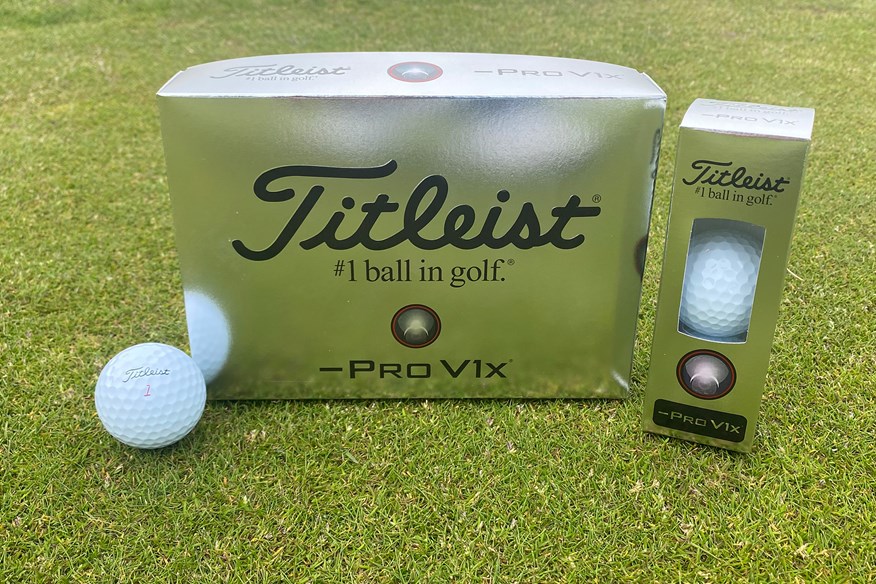

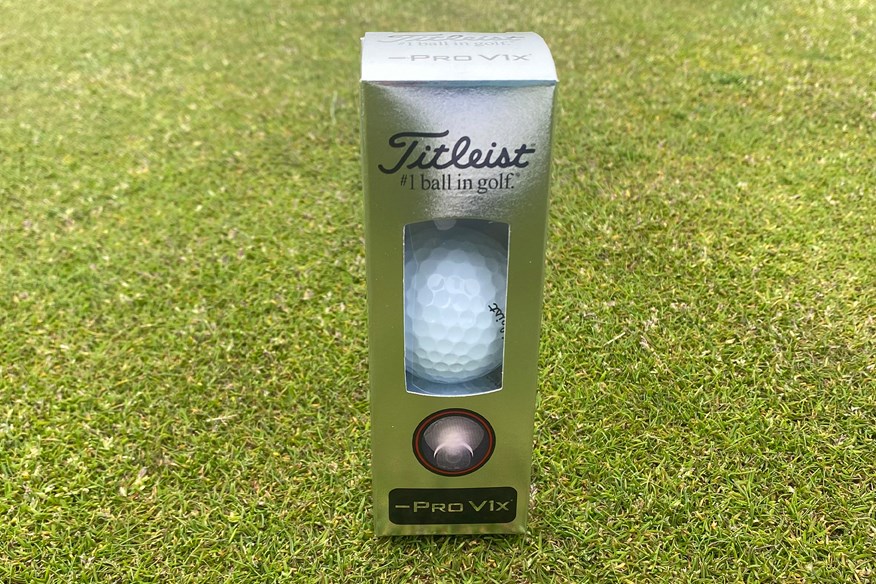
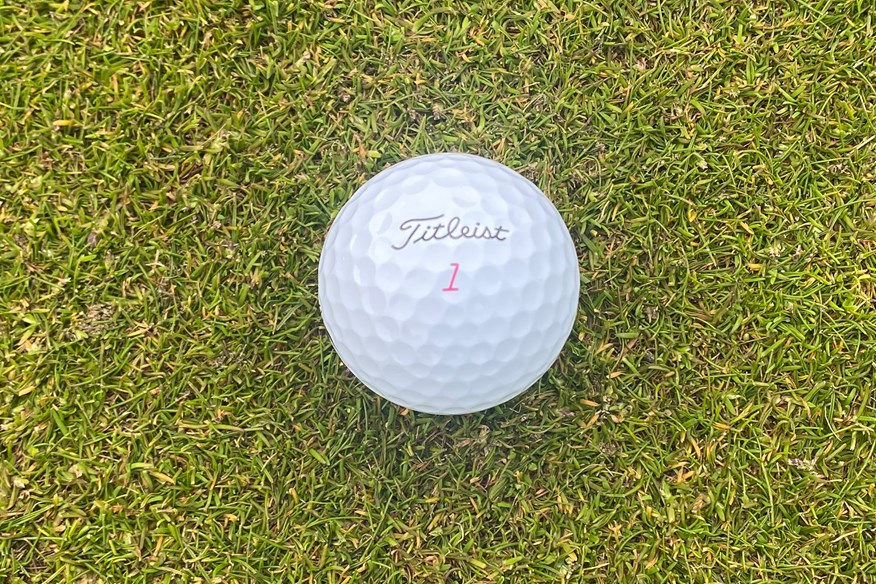
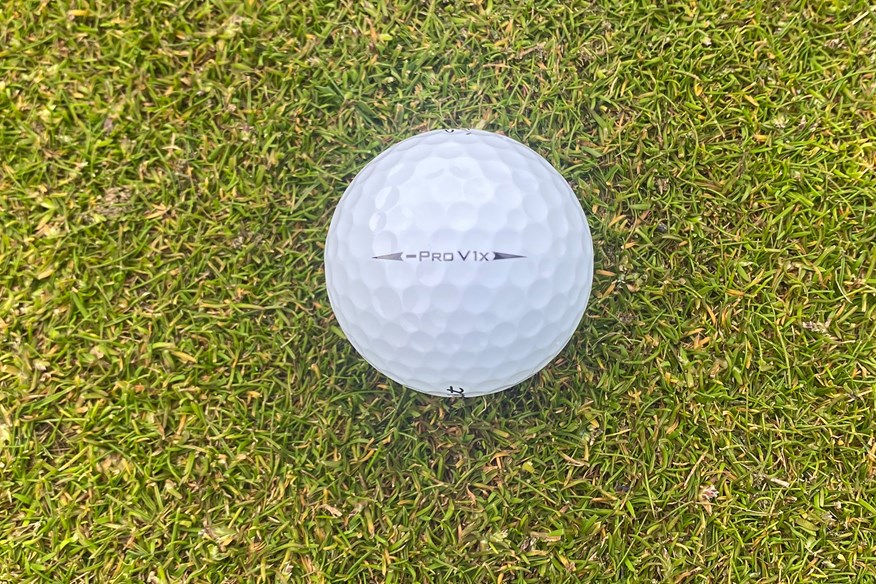
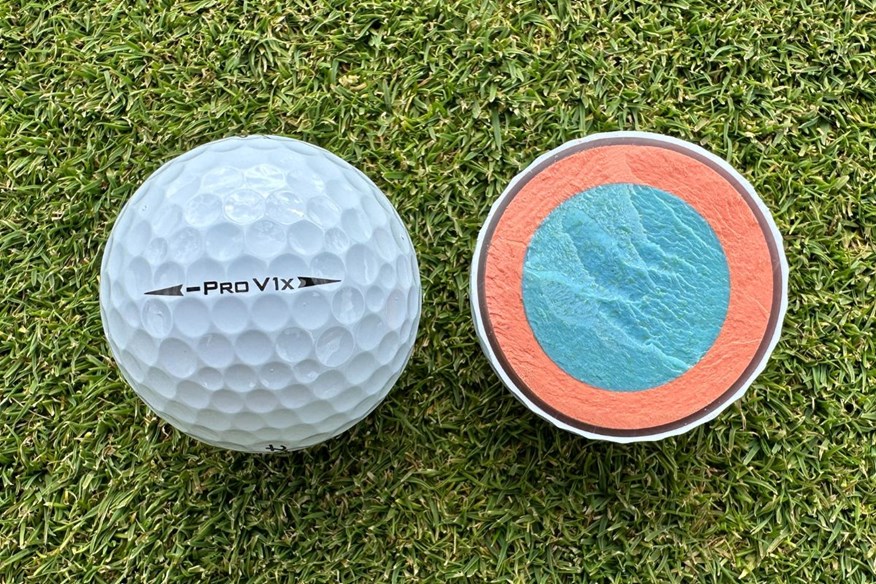
The Pro V1x Left Dash is Titleist's fastest golf ball, but it's not the fastest golf ball out there. At 114mph, that speed materialises into great distance - being one of only three golf balls to exceed 274 yards in the entire test.
Once you begin to slow down, the Pro V1x Left Dash becomes much less efficient in its performance. If you have a quick swing speed, this golf ball is going to serve you well off the tee (second place overall). However, at 93mph, this is the third lowest performing golf ball in this category, and at 78mph, it's the second lowest performing.
Also, it becomes a struggle to generate sufficient ball speed to maximise distance, and it's a similar story in the iron and wedge game.
Titleist sells the Pro V1x Left Dash as a low-spin golf ball that flies similarly to the Pro V1x, and our data supports this. With a 7-iron, the Pro V1x Left Dash has the lowest descent angle, and on the 40-yard pitch shot, it generates the lowest spin.
Sticking true to its low-spin nature, the Pro V1x Left Dash is the lowest-spinning four-piece golf ball on test, generating 17,692rpm across all three driver swing speeds, the 7-iron shot, and the 40-yard pitch - nearly 500rpm less than the second-lowest-spinning four-piece model.
The Pro V1x Left Dash is perfect if you swing like Bryson DeChambeau and generate tons of spin, but if not, this is a golf ball you're well worth steering clear of.
On-course verdict
When I played the Titleist Pro V1x Left Dash, I immediately noticed how high it launched and how consistent it was from tee to green. It felt firm but still premium, giving me clear feedback on every shot, especially on putts where the response was spot-on.
The ball held up really well over a round, too, with hardly any scuffing. Off the tee, I gained distance thanks to its low spin and towering flight, but I did have to adjust my expectations around the greens - there just wasn’t as much spin or bite as I get with the Pro V1 or Pro V1x.
For me, it’s a ball that shines when I want extra distance and control in the long game, but it’s not the most forgiving choice if I need finesse and stopping power in the short game.
Read our full Titleist Pro V1x Left Dash golf ball review.
Pros
- Consistent towering ball flight
- Competitive long game distance
- Solid feedback throughout the bag
Cons
- Not as versatile as the Pro V1 or Pro V1x
| Carry distance (yds) | Driver 114mph - 274.3 | Driver 93mph - 208.7 | Driver 78mph - 160 | 7-iron - 155.9 |
| Ball speed (mph) | Driver 114mph - 164.3 | Driver 93mph - 133.7 | Driver 78mph - 112.6 | 7-iron - 108.3 |
| Backspin (rpm) | Driver 114mph - 2,587 | Driver 93mph - 2,575 | Driver 78mph - 2,446 | 7-iron - 4,453 | Pitch - 5,631 |
| Launch angle (°) | Driver 114mph - 11.1 | Driver 93mph - 12.9 | Driver 78mph - 14 | 7-iron - 21.1 | Pitch - 31.3 |
| Descent angle (°) | Driver 114mph - 36.5 | Driver 93mph - 31.7 | Driver 78mph - 27.3 | 7-iron - 44.5 | Pitch - 36.6 |
| Peak height (yds) | Driver 114mph - 31.7 | Driver 93mph - 21.1 | Driver 78mph - 15.4 | 7-iron - 29 | Pitch - 6.9 |
| Compression (psi) | 114 |
- Firm cast urethane elastomer cover system
- Fast, low-spin casing layer
- ZG Process Core
- Spherically-tiled 328 tetrahedral dimple design
- 4-Piece construction
- Available in white only
- Alternative models include AIM Enhanced and RCT
Silver medal for approach play performance
Best Srixon low-spin golf ball
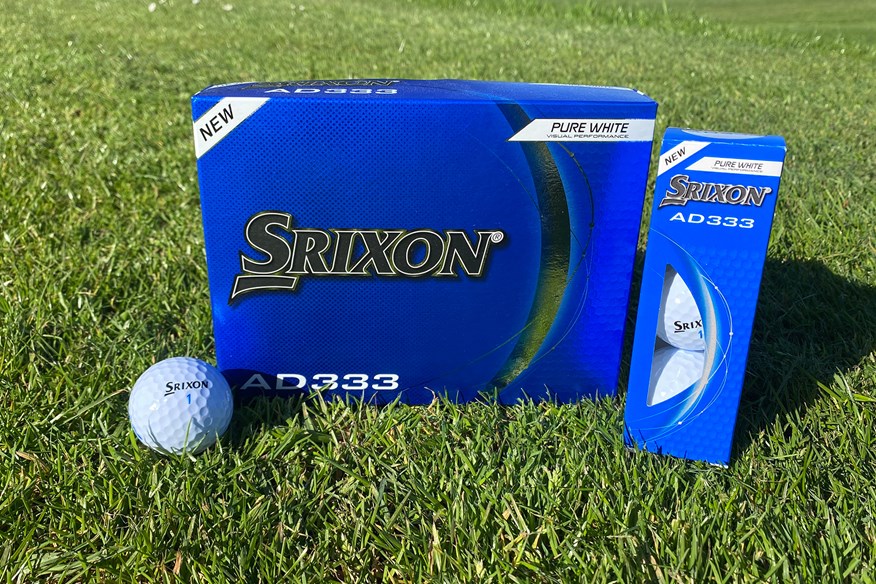

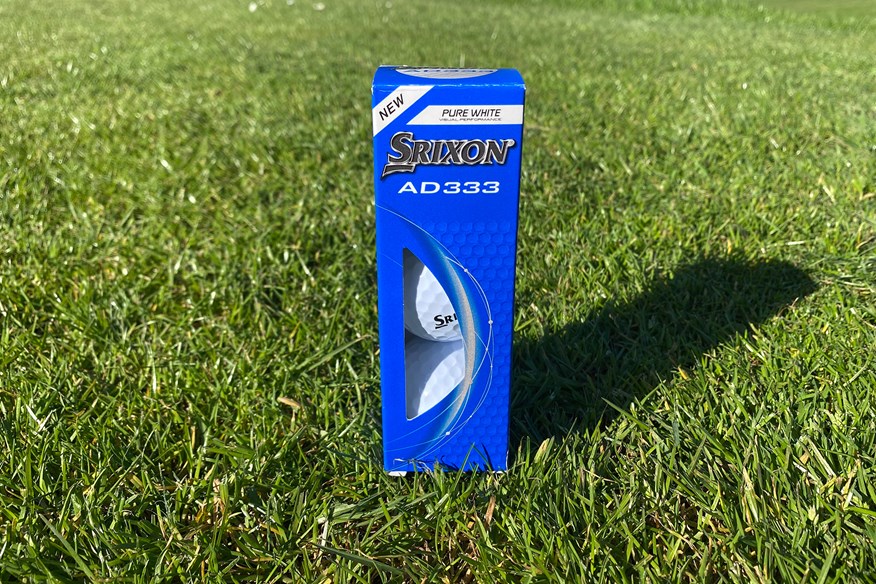
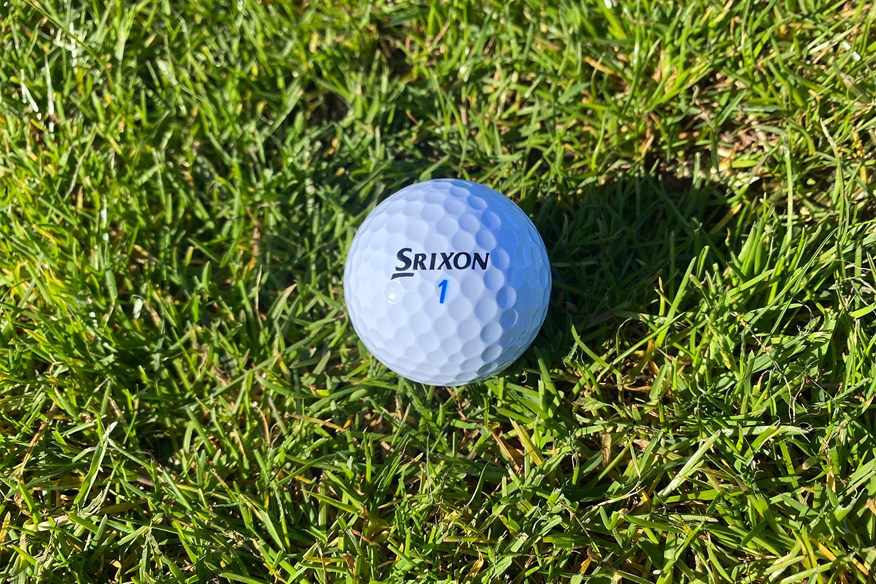
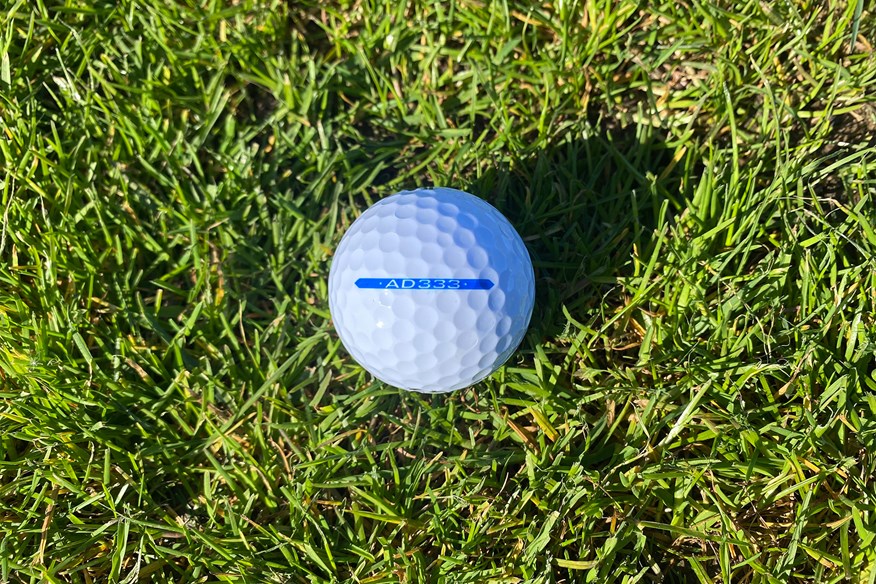
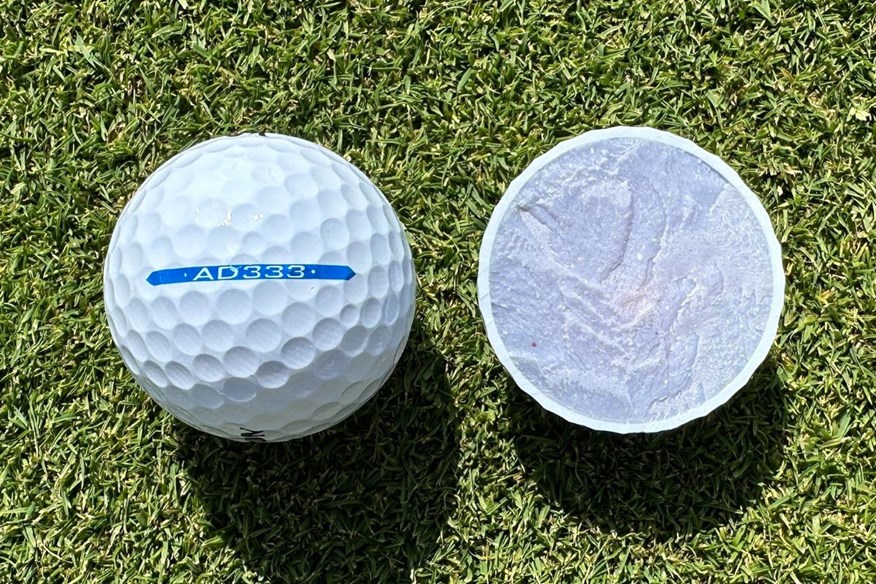
The Srixon AD333 is yet another Srixon golf ball that performs noticeably well in approach play performance.
This is the fifth Srixon golf ball to pick up an award for approach play performance - the silver medal. Not only is the AD333 the second-best two-piece golf ball in this area, but it's also the 16th best out of all 62 tested.
A big reason for the AD333 performing so well in approach play is its carry distance consistency, ranking 13th overall. There is certainly a pattern between Srixon golf balls and delivering a consistent distance.
In short game performance, the AD333 is the seventh-highest-spinning two-piece model, sitting just below the test average with 5,674rpm.
Off-the-tee performance isn't overly strong from the AD333, finishing towards the middle of the pack at all three driver swing speeds.
The AD333 is the best two-piece Srixon golf ball, and if you're looking for a ball to trust when attacking pins, you can't go wrong with this model.
This isn't the lowest-spinning Srixon golf ball, but it is the best Srixon low-spin golf ball. Across all three driver swing speeds, the 7-iron shot, and the 40-yard pitch, this model generates 17,766rpm, making it higher-spinning than the UltiSoft (by over 1,200rpm) and the Soft Feel (by nearly 300rpm), but based on the performance of the other two models, I would recommend this as the best Srixon low-spin golf ball.
On-course verdict
The Srixon AD333 is a hugely popular golf ball all across the globe because it's a very reasonable price and it delivers repeatable performance.
With the AD333, golfers know what to expect, and while it might not be Tour-level performance, for the vast majority of amateur golfers, it's good enough to allow them to enjoy 18 holes.
I'm not a massive fan of the AD333, but it doesn't suit my game. Also, I find the feel and sound to be quite clicky.
Pros
- Strong approach play performance
- Admirable short game spin and control
- Popular model among amateurs
Cons
- Not a massive fan of the sound and feel
| Carry distance (yds) | Driver 114mph - 266.4 | Driver 93mph - 204.5 | Driver 78mph - 159.9 | 7-iron - 155.8 |
| Ball speed (mph) | Driver 114mph - 160.8 | Driver 93mph - 132.1 | Driver 78mph - 112.4 | 7-iron - 108 |
| Backspin (rpm) | Driver 114mph - 2,685 | Driver 93mph - 2,649 | Driver 78mph - 2,371 | 7-iron - 4,387 | Pitch - 5,674 |
| Launch angle (°) | Driver 114mph - 11 | Driver 93mph - 12.7 | Driver 78mph - 14.2 | 7-iron - 21.5 | Pitch - 31.4 |
| Descent angle (°) | Driver 114mph - 36.5 | Driver 93mph - 31.4 | Driver 78mph - 27.3 | 7-iron - 44.8 | Pitch - 37.1 |
| Peak height (yds) | Driver 114mph - 30.9 | Driver 93mph - 21.3 | Driver 78mph - 15.5 | 7-iron - 29.5 | Pitch - 7.3 |
| Compression (psi) | 68 |
- FastLayer core
- Spin Skin with SeRM
- Speed dimple pattern
- 338 dimples
- 2-Piece construction
- Available in white and yellow
Silver medal for tee to green performance at 93mph and 78mph and short game performance
The Warbird Distance+ is Callaway's cheapest golf ball, but it certainly doesn't perform as though it is. This model scooped up the second-most awards in the two-piece category.
Tee to green performance is incredibly strong at all three swing speeds. The Warbird Distance+ won silver at 93mph and 78mph, and bronze at 114mph. Distance is definitely a strong factor, being the third-best golf ball off the tee in this category.
However, this golf ball isn't purely a distance model (despite it being in its name). For short game performance, the Warbird Distance+ is the second-highest-spinning two-piece model (5,963rpm) and the third-highest-spinning Callaway golf ball.
Despite this model's high short game performance, the Warbird Distance+ is still among the best low-spin golf balls because it generates optimal spin in the right area. Hugely impressive for a two-piece golf ball.
The Warbird Distance+ produces 17,876rpm across all three driver swing speeds, the 7-iron shot, and the 40-yard pitch.
We're really impressed by the overall performance of the Warbird Distance+. It's firmly put this golf ball on our radar, and with its test results, it should be for you, too!
On-course verdict
I didn't have particularly high hopes for the Callaway Warbird Distance+ given its price, construction, and name, but I'm happy to have been proven wrong.
The Warbird Distance+ doesn't feel the greatest. It's slightly clicky and clunky, which doesn't make the feedback and response very pleasant, but if you can look past that, this is a solid golf ball from tee to green.
Despite being a distance golf ball, the Warbird Distance+ offers much more than solely distance. This golf ball produces high-spin when attacking pins with an iron and wedge - something you don't always expect from a distance golf ball, but it's always appreciated.
Although the Warbird Distance+ offers more than distance, distance is very impressive with this model, thanks to the reduced spin. The carry distance is long, but the ball continues to roll a long way, delivering amazing total distance.
The Warbird Distance+ might not jump out as a must-have golf ball, but you won't be disappointed if you give it a go - I most certainly wasn't.
Pros
- Solid tee to green performance
- Surprisingly strong short-game performance
- Impressive distance
Cons
- Not the nicest feel
| Carry distance (yds) | Driver 114mph - 270.9 | Driver 93mph - 209.2 | Driver 78mph - 161.3 | 7-iron - 157.9 |
| Ball speed (mph) | Driver 114mph - 163 | Driver 93mph - 133.7 | Driver 78mph - 113 | 7-iron - 108.7 |
| Backspin (rpm) | Driver 114mph - 2,683 | Driver 93mph - 2,611 | Driver 78mph - 2,346 | 7-iron - 4,273 | Pitch - 5,963 |
| Launch angle (°) | Driver 114mph - 11.1 | Driver 93mph - 13 | Driver 78mph - 14.2 | 7-iron - 21.6 | Pitch - 30.7 |
| Descent angle (°) | Driver 114mph - 36.8 | Driver 93mph - 32.2 | Driver 78mph - 27.3 | 7-iron - 44.9 | Pitch - 36.1 |
| Peak height (yds) | Driver 114mph - 31.7 | Driver 93mph - 22.5 | Driver 78mph - 15.6 | 7-iron - 29.9 | Pitch - 6.9 |
| Compression (psi) | 92 |
- Extra-large, high-energy core
- Hex aerodynamics
- 332 dimples
- 2-Piece construction
- Available in white and yellow
No.1 3-piece club golfer model
This is one of my most highly anticipated golf balls of the entire test. Ever since I tested the Vice Tour on-course, I've been waiting to see how it would perform in our robot test. I'm very pleasantly surprised.
I'm a fan of the Tour, but I never expected this golf ball would scoop up five awards in the three-piece club golfer category. As well as being the best golf ball for tee to green performance at 114mph, the Tour won the silver medal for tee to green performance at 93mph, off-the-tee performance, and short game performance, plus the bronze medal for tee to green performance at 78mph.
This golf ball is the real deal - and it doesn't have a urethane cover. That's quite possibly a reason as to why it's low-spinning when approaching greens (4,216rpm). However, around the greens, that spin shoots up, and it's the second-highest-spinning model with 5,967rpm (14th overall).
Short game and approach play performance is very clearly solid, but off the tee is where the Tour really gets you excited. At 114mph, this is the longest (271.4yds) and second-fastest (163.3mph) golf ball, at 93mph, it's the longest (208.3yds) and third-fastest (133.4mph), and at 78mph, it's the second-longest (160.8yds) and second-fastest (113.2mph).
The Vice Tour delivers optimal spin where required, and that helps it feature among the best low-spin golf balls. Despite being high-spinning in the 40-yard shot, this model generates 17,968rpm across all three driver swing speeds, the 7-iron shot, and the 40-yard pitch. This is the three-piece model to consider if you're looking for all-around performance.
There's a ton to like about the Vice Tour, and factoring in the price, as well as its domination, this is the best three-piece club golfer model.
On-course verdict
I would say the Vice Tour is a suitable option for a wide range of golfers because, as a whole, it’s a decent, well-rounded golf ball.
One area where the Vice Tour impresses me is with how well it propels off the face of a long iron. Distance is strong even into the wind, and there’s a more pleasant feedback from this ball than I feel from any of the golf balls in Vice’s Pro range.
I wouldn’t go as far as to say the Vice Tour is a soft-feeling golf ball or a firm-feeling golf ball. I would place it somewhere in the middle, with a medium feel.
Having played with Vice’s Pro Plus, Pro, and Pro Air golf balls, I would say that this golf ball is more responsive than all of those. The feel off the face isn’t as profound as other golf balls I’ve played with, but it definitely isn’t as muted as other Vice golf balls.
This helps to provide more feedback from your shot, which is something I like, but it isn’t something that every golfer wants. The responsiveness of the Vice Tour could be better, but for a golf ball with a Surlyn cover, it’s pretty good.
Whether you have a fast swing speed or a slow swing speed, the Vice Tour should definitely be on your radar.
Read our full Vice Tour golf ball review.
Pros
- Consistent and tight dispersion
- Impressive on-course distance
- Incredible value for money
Cons
- Not much grab on short approach shots
| Carry distance (yds) | Driver 114mph - 271.4 | Driver 93mph - 208.3 | Driver 78mph - 160.8 | 7-iron - 158.1 |
| Ball speed (mph) | Driver 114mph - 163.3 | Driver 93mph - 133.4 | Driver 78mph - 113 | 7-iron - 108.7 |
| Backspin (rpm) | Driver 114mph - 2,769 | Driver 93mph - 2,635 | Driver 78mph - 2,381 | 7-iron - 4,216 | Pitch - 5,967 |
| Launch angle (°) | Driver 114mph - 11.1 | Driver 93mph - 13 | Driver 78mph - 14 | 7-iron - 21.5 | Pitch - 30.6 |
| Descent angle (°) | Driver 114mph - 37.7 | Driver 93mph - 32.2 | Driver 78mph - 27.3 | 7-iron - 44.6 | Pitch - 35.8 |
| Peak height (yds) | Driver 114mph - 32.6 | Driver 93mph - 22.4 | Driver 78mph - 15.5 | 7-iron - 29.6 | Pitch - 6.7 |
| Compression (psi) | 112 |
- Enhanced mid-acid Surlyn cover
- High resilience and low stiffness composition
- Size-optimized High Energy Speed Core (HESC)
- 312 dimples
- 3-Piece construction
- Available in white and grey
Best low-spin golf balls 2025: Robot test data
| Golf ball | TaylorMade Distance+ | Titleist Velocity | Seed SD-15 | Titleist AVX | Callaway ERC Soft | Wilson Triad | Titleist Pro V1x Left Dash | Srixon AD333 | Callaway Warbird Distance+ | Vice Tour |
| Compression | 95 | 101 | 64 | 84 | 87 | 89 | 114 | 68 | 92 | 112 |
| 114mph Driver Ball Speed (mph) | 162.9 | 163.2 | 159.6 | 162.8 | 162.5 | 161.7 | 164.3 | 160.8 | 163 | 163.3 |
| 114mph Driver Launch Angle (°) | 11.1 | 11.1 | 11 | 11.1 | 11.1 | 11.2 | 11.1 | 11.2 | 11.1 | 11.1 |
| 114mph Driver Backspin (rpm) | 2704 | 2677 | 2612 | 2613 | 2690 | 2734 | 2587 | 2685 | 2683 | 2769 |
| 114mph Driver Carry Distance (yds) | 270.9 | 271.5 | 263.5 | 271.1 | 269.9 | 268.2 | 274.3 | 266.4 | 270.9 | 271.4 |
| 114mph Driver Height (yds) | 32 | 31.8 | 29.5 | 31.4 | 31.5 | 31.7 | 31.7 | 30.9 | 31.7 | 32.6 |
| 114mph Driver Descent Angle (°) | 37.1 | 36.9 | 35.4 | 36.4 | 36.8 | 37.1 | 36.5 | 36.5 | 36.8 | 37.7 |
| 93mph Driver Ball Speed (mph) | 133.4 | 133.5 | 131.7 | 133.3 | 133.5 | 132.6 | 133.7 | 132.1 | 133.7 | 133.4 |
| 93mph Driver Launch Angle (°) | 13 | 13.2 | 13 | 13.0 | 12.9 | 12.7 | 12.9 | 12.7 | 13 | 13.0 |
| 93mph Driver Backspin (rpm) | 2476 | 2467 | 2482 | 2606 | 2596 | 2707 | 2575 | 2649 | 2611 | 2635 |
| 93mph Driver Carry Distance (yds) | 208.3 | 208.9 | 204 | 208.1 | 208.3 | 205.6 | 208.7 | 204.5 | 209.2 | 208.3 |
| 93mph Driver Height (yds) | 21.8 | 22.2 | 21.1 | 22.3 | 22.2 | 21.8 | 22.1 | 21.3 | 22.5 | 22.4 |
| 93mph Driver Descent Angle (°) | 31.2 | 31.5 | 30.8 | 32.0 | 31.8 | 31.9 | 31.7 | 31.4 | 32.2 | 32.2 |
| 78mph Driver Ball Speed (mph) | 113 | 112.9 | 112 | 112.9 | 113.2 | 112.5 | 112.6 | 112.4 | 113 | 113.0 |
| 78mph Driver Launch Angle (°) | 14.1 | 14.2 | 14.4 | 14.0 | 14.0 | 13.9 | 14.0 | 14.2 | 14.2 | 14.0 |
| 78mph Driver Backspin (rpm) | 2314 | 2261 | 2233 | 2408 | 2388 | 2546 | 2446 | 2371 | 2346 | 2381 |
| 78mph Driver Carry Distance (yds) | 161 | 160.6 | 158.9 | 160.4 | 161.4 | 159.7 | 160.0 | 159.9 | 161.3 | 160.8 |
| 78mph Driver Height (yds) | 15.4 | 15.3 | 15.2 | 15.3 | 15.5 | 15.5 | 15.4 | 15.5 | 15.6 | 15.4 |
| 78mph Driver Descent Angle (°) | 27 | 26.8 | 26.8 | 27.1 | 27.3 | 27.6 | 27.3 | 27.3 | 27.3 | 27.1 |
| 7-Iron Ball Speed (mph) | 108.5 | 108.7 | 108.3 | 108.2 | 108.6 | 108.5 | 108.3 | 108 | 108.7 | 108.7 |
| 7-Iron Launch Angle (°) | 21.2 | 21.9 | 21.7 | 21.2 | 21.6 | 21.1 | 21.1 | 21.5 | 21.6 | 21.5 |
| 7-Iron Backspin (rpm) | 4596 | 3801 | 4170 | 4429 | 4154 | 4474 | 4453 | 4387 | 4273 | 4216 |
| 7-Iron Carry Distance (yds) | 155.7 | 160.6 | 157.6 | 156.0 | 158.4 | 156.4 | 155.9 | 155.8 | 157.9 | 158.1 |
| 7-Iron Height (yds) | 29.6 | 29.6 | 29.6 | 29.2 | 29.7 | 29.3 | 29.0 | 29.5 | 29.9 | 29.6 |
| 7-Iron Descent Angle (°) | 45.1 | 44 | 44.6 | 44.7 | 44.6 | 44.7 | 44.5 | 44.8 | 44.9 | 44.6 |
| 40-Yard Pitch Ball Speed (mph) | 45.7 | 46.4 | 46.9 | 46.4 | 46.6 | 46.6 | 45.7 | 46.9 | 46.7 | 46.1 |
| 40-Yard Pitch Launch Angle (°) | 36.5 | 31.2 | 31.4 | 32.0 | 31.4 | 31.2 | 31.3 | 31.4 | 30.7 | 30.6 |
| 40-Yard Pitch Backspin (rpm) | 3685 | 5789 | 5667 | 5318 | 5592 | 5554 | 5631 | 5674 | 5963 | 5967 |
| 40-Yard Pitch Carry Distance (yds) | 40.8 | 40.2 | 41.1 | 40.6 | 40.6 | 40.5 | 39.1 | 41.1 | 40.3 | 39.3 |
| 40-Yard Pitch Height (yds) | 8.9 | 7.1 | 7.3 | 7.4 | 7.3 | 7.2 | 6.9 | 7.3 | 6.9 | 6.7 |
| 40-Yard Pitch Descent Angle (°) | 42.7 | 36.7 | 37.1 | 37.9 | 37.1 | 36.9 | 36.6 | 37.1 | 36.1 | 35.8 |
Best low-spin golf balls 2025: Buying guide
Ability
Ability will play a massive part in whether you’ll need a low-spinning golf ball or even if you’d benefit from a low-spinning golf ball. Ability doesn’t really apply to your handicap or what you score on the course; it relates more to your swing and how you present the club at impact.
What I mean by this is, you may be a golfer who is incapable of generating spin because of the way you swing and how you hit the ball. However, you might produce ample spin for the same reasons. Certain golfers – depending on skill level – will be able to manipulate their swing to reduce or increase spin, but realistically, those golfers will be playing on a Tour somewhere in the world. If you have quite a steep swing and hit down on the ball, typically, you would benefit from playing a low-spin golf ball.
Budget
Working to a budget or specific price point when you’re in the market for low-spin golf balls is much easier than if you’re looking for high-spin golf balls. This is because most of the best low-spin golf balls are distance golf balls, intended for beginners and high-handicappers, or cheap golf balls. Certain low-spin golf balls are more premium than others, and they are higher priced, but it’s worth checking whether they will benefit your game before spending the extra cash.
If it’s the case that you do require a low-spin golf ball, then it might mean that you don’t need to have as tight a budget elsewhere because you should be able to spend slightly less than you would have if you needed a high-spinning golf ball.
Feel
No matter whether your preference is for a firmer-feeling golf ball or a softer-feeling golf ball, you’ll be able to find your preference if you need to play with a high-spin golf ball. Feel doesn’t directly correlate to spin, despite what some golfers believe.
The softest low-spin golf ball is the Seed SD-15, based on compression ratings, and the firmest is the Titleist Pro V1x Left Dash. That being said, I wouldn’t necessarily classify any models as being firm; they are just firmer than soft.
Distance
If you’re in the market for golf balls that deliver low spin, then chances are distance is a vital aspect you’re considering. However, just because you’re interested in playing with golf balls that reduce spin doesn’t mean distance is the only relevant factor.
With many of the best low-spin golf balls being distance golf balls, you can guarantee they will produce competitive distance. That being said, the best high-spin golf balls are still capable of producing impressive distance – hence why they tend to be the most popular premium golf balls played on Tour. Therefore, if you are someone who wants distance and spin, then it’s worth taking a look at those instead.
Color
The most common golf ball color is white; however, there are plenty of other colors and designs to choose from. More vibrant colors, such as yellow, orange, or green, are all easy to pick up, and they help some people with visibility – hence why they make for the best winter golf balls.
Other ways of adding color to the golf ball can be by design, whether it be a splash of color seen on Vice golf balls or an alignment design which also helps with visibility, such as TaylorMade’s Pix golf balls or Callaway’s Triple Track golf balls.
If you’ve only ever played with white golf balls, it might be worth trying a more colorful golf ball, especially if you’re always the one asking your playing partners, “Where did that one go?”.
Alignment
More and more golf balls are being released with enhanced alignment, and even standard golf balls have a more prominent alignment stamp now than they’ve ever had. The majority of brands now offer golf balls with enhanced alignment aids. The enhanced alignment aids can be extremely useful for putting and even lining up shots on the tee. Another plus of alignment golf balls is the alignment serves as a tool for finding your golf ball either in the air or among the trees.

